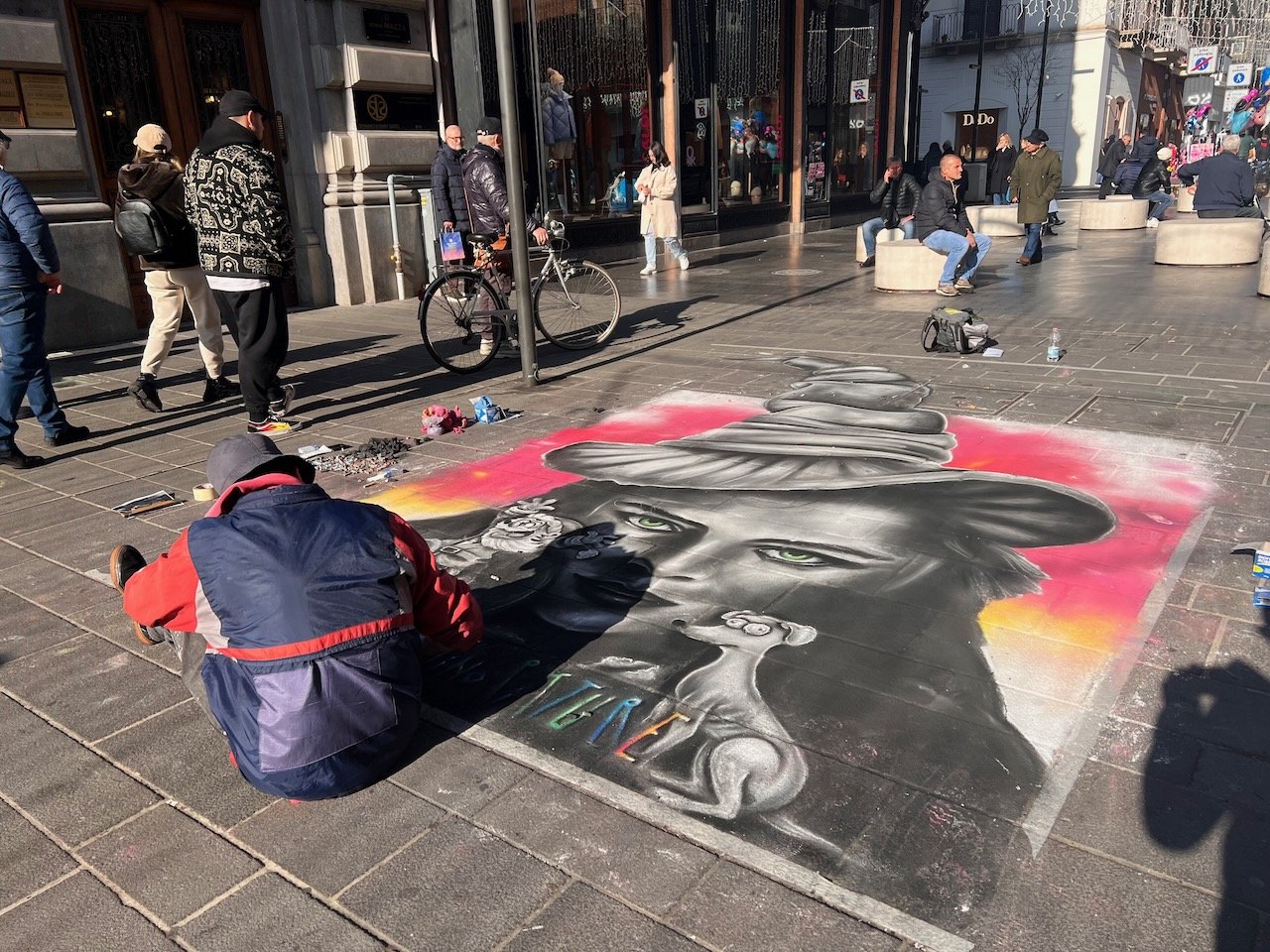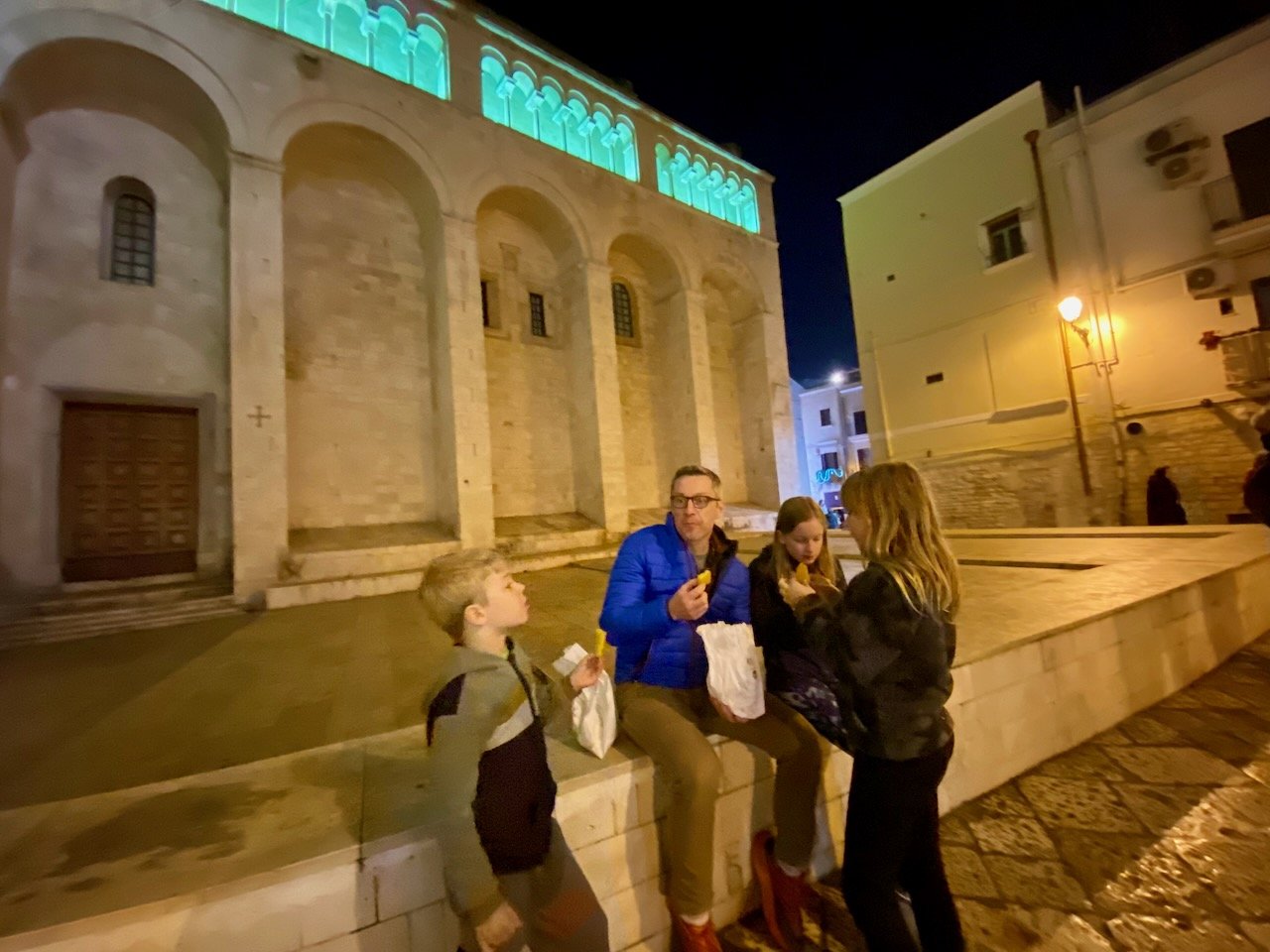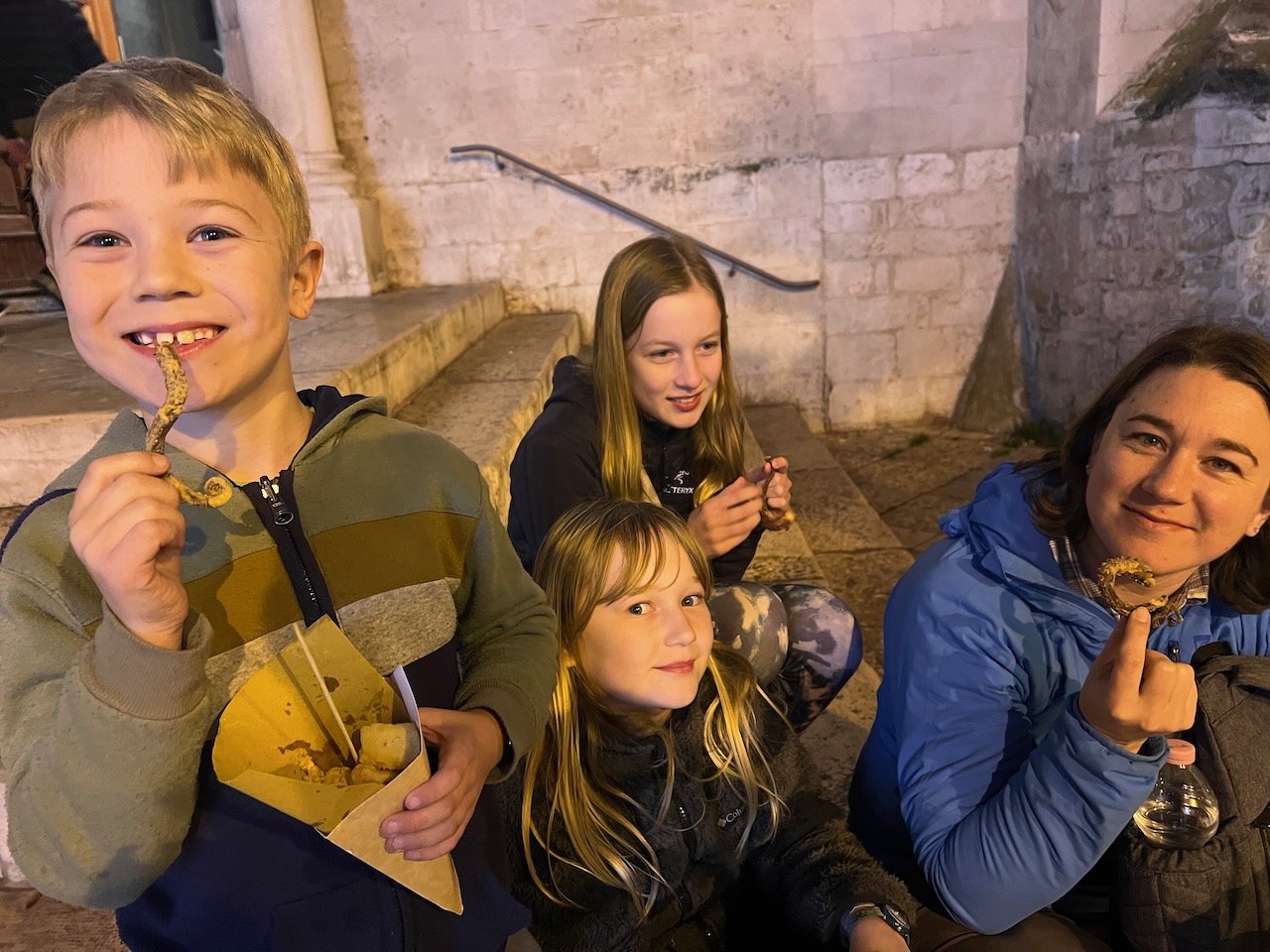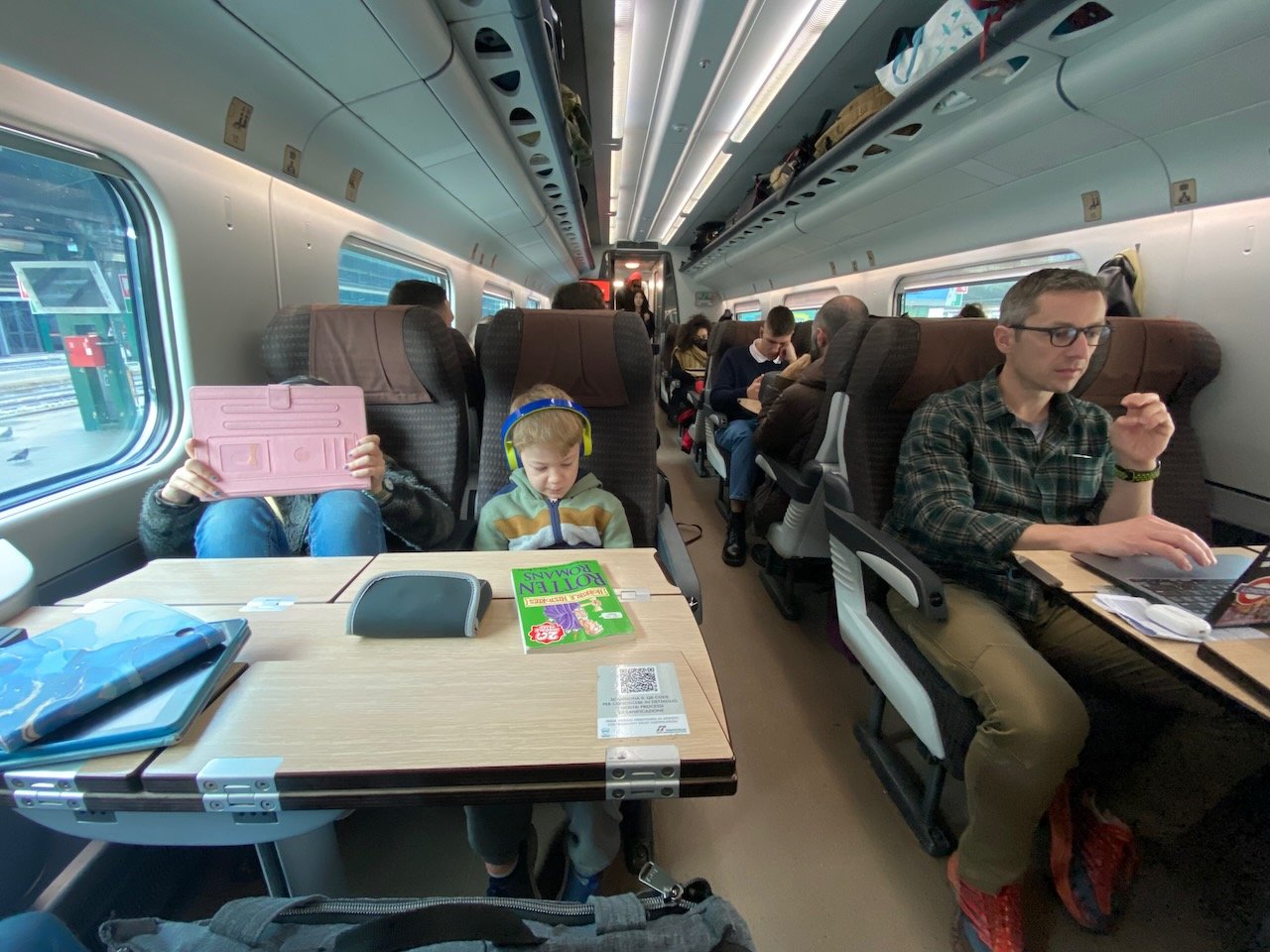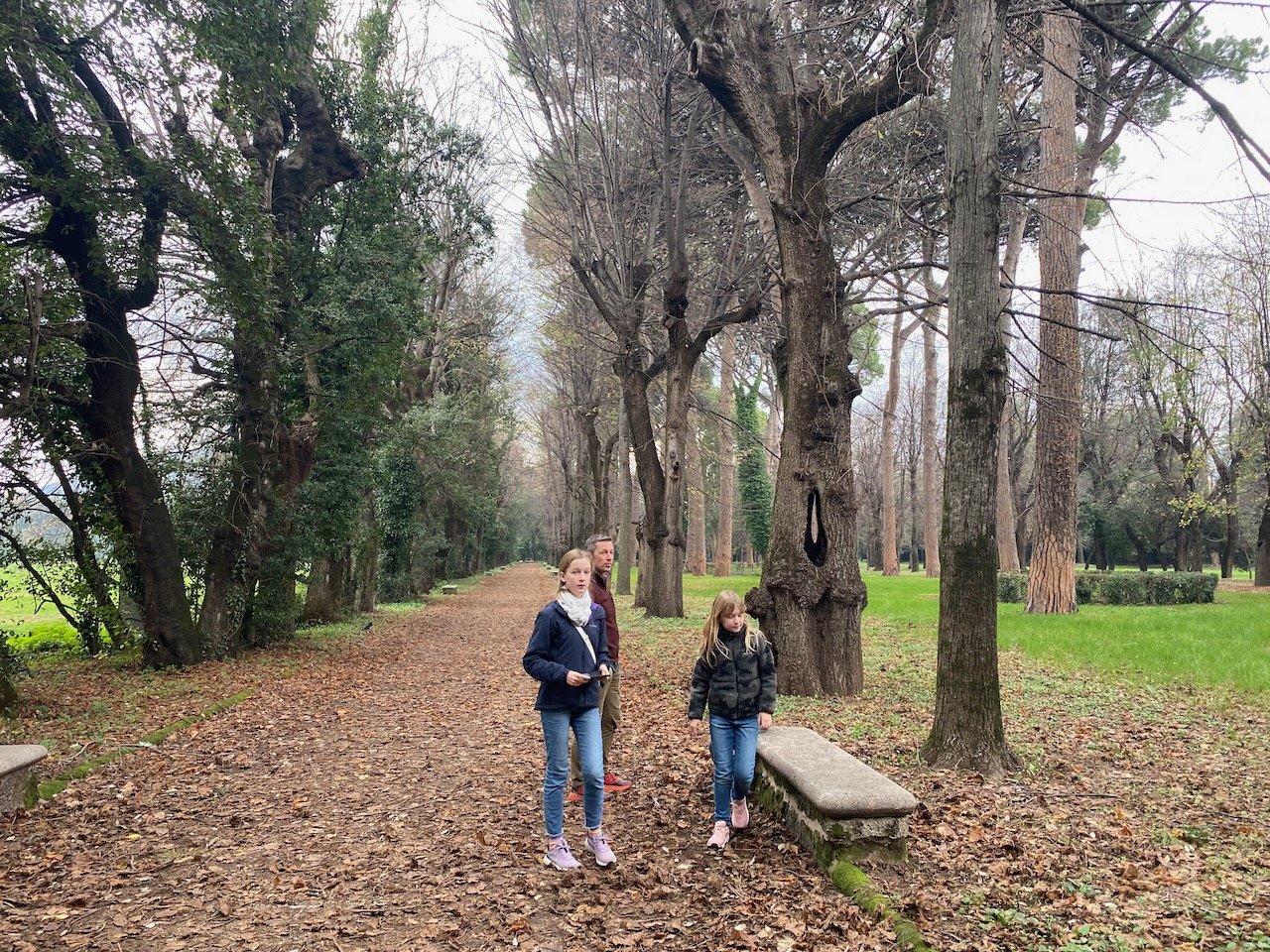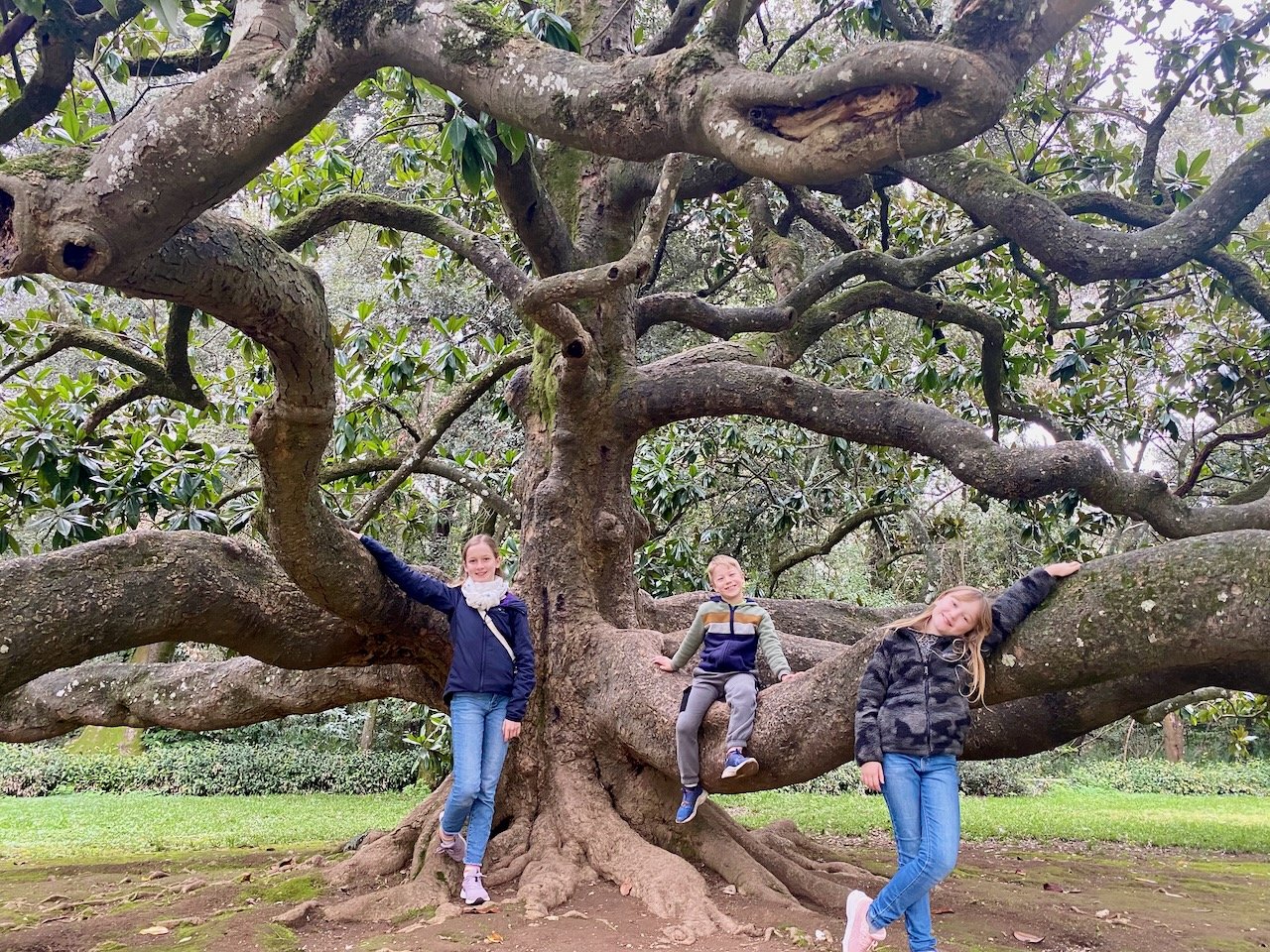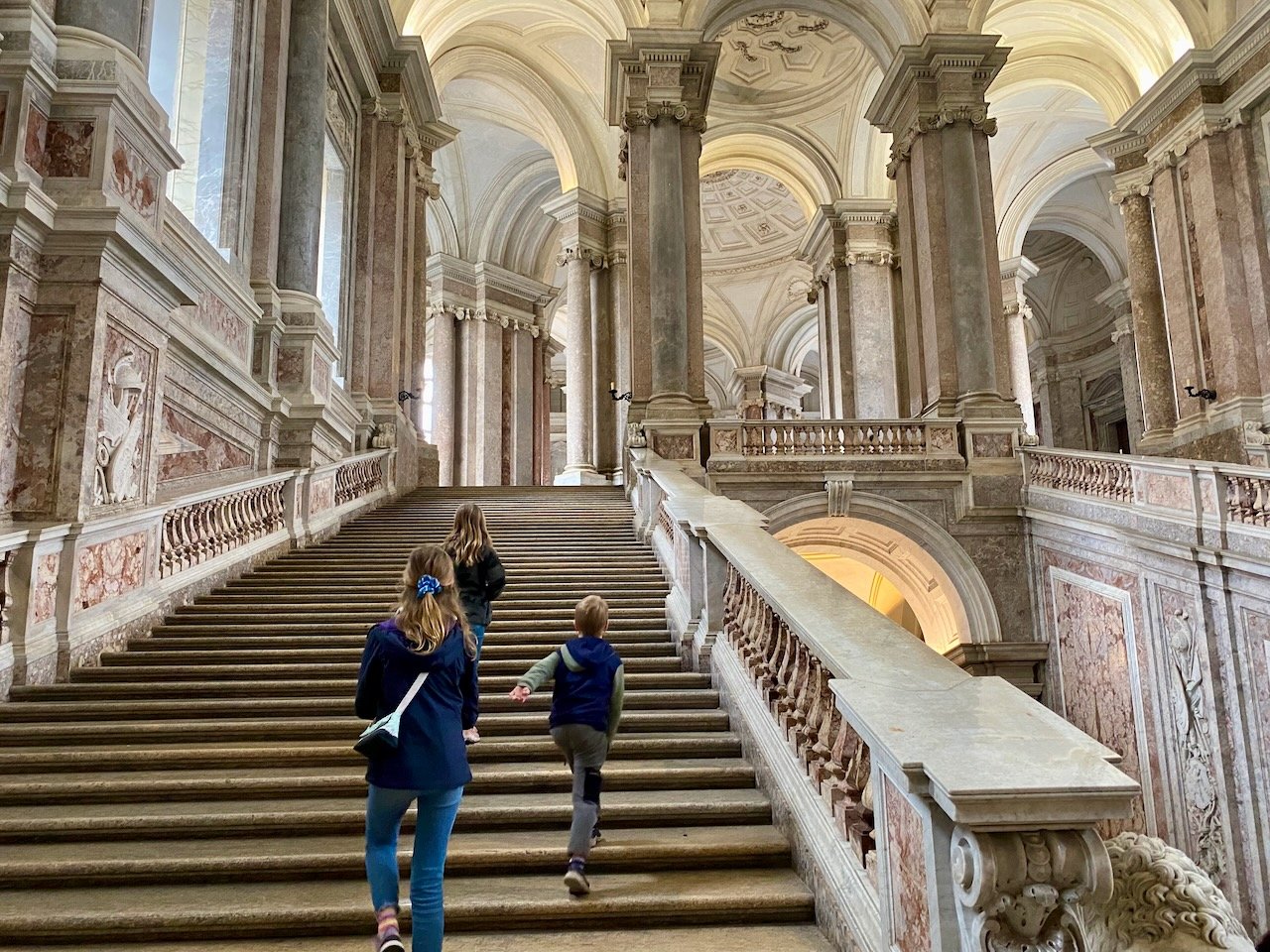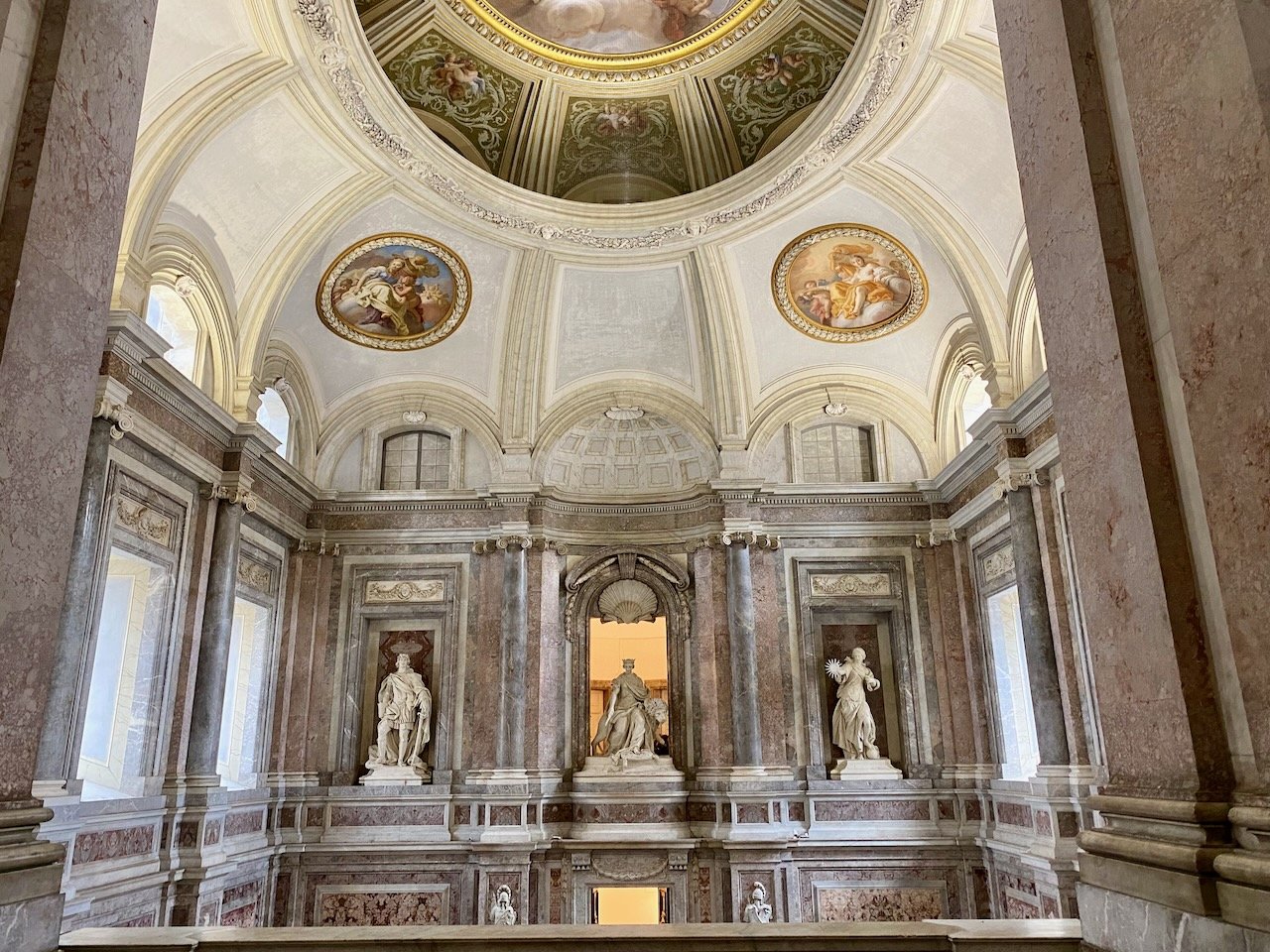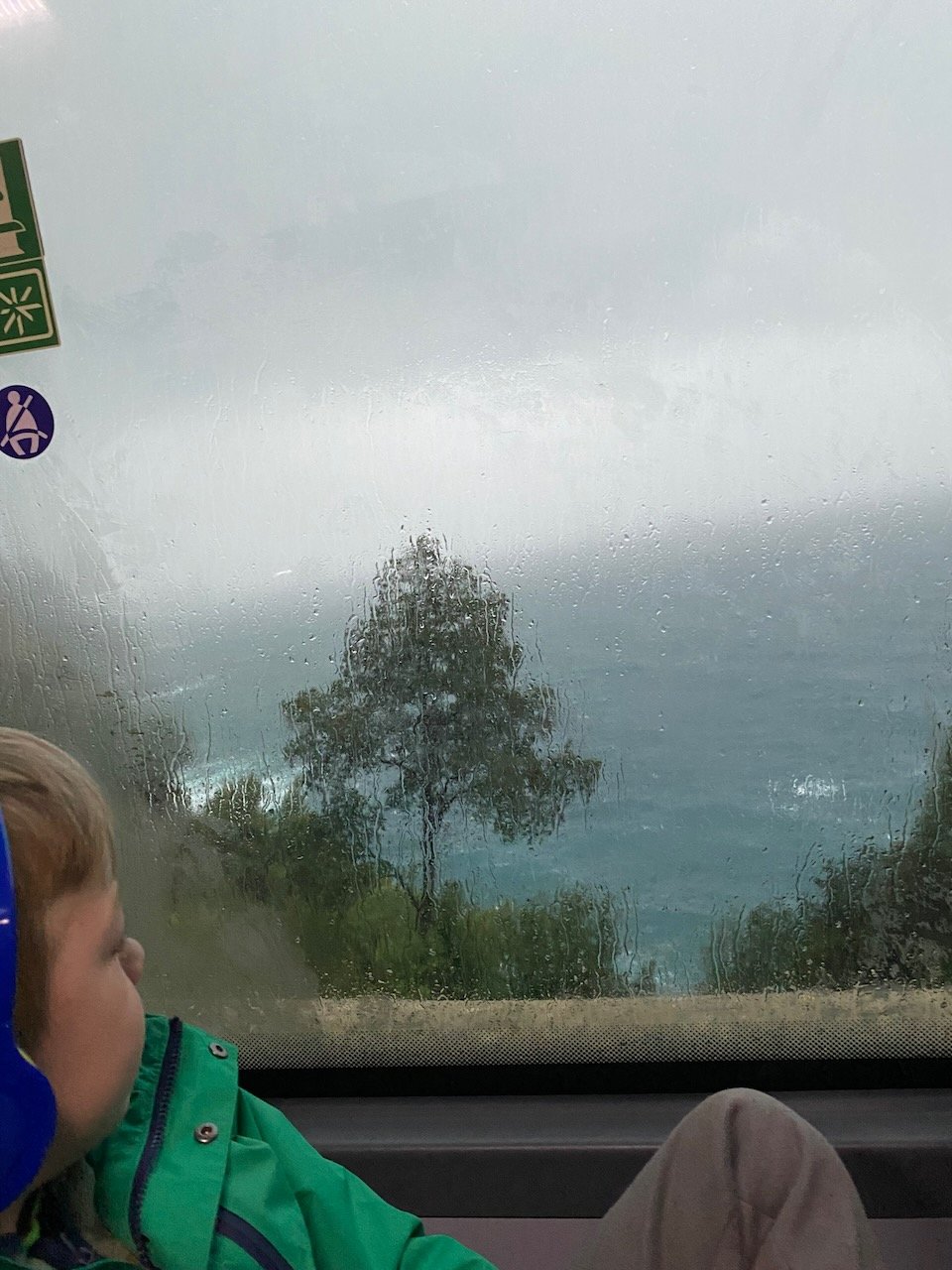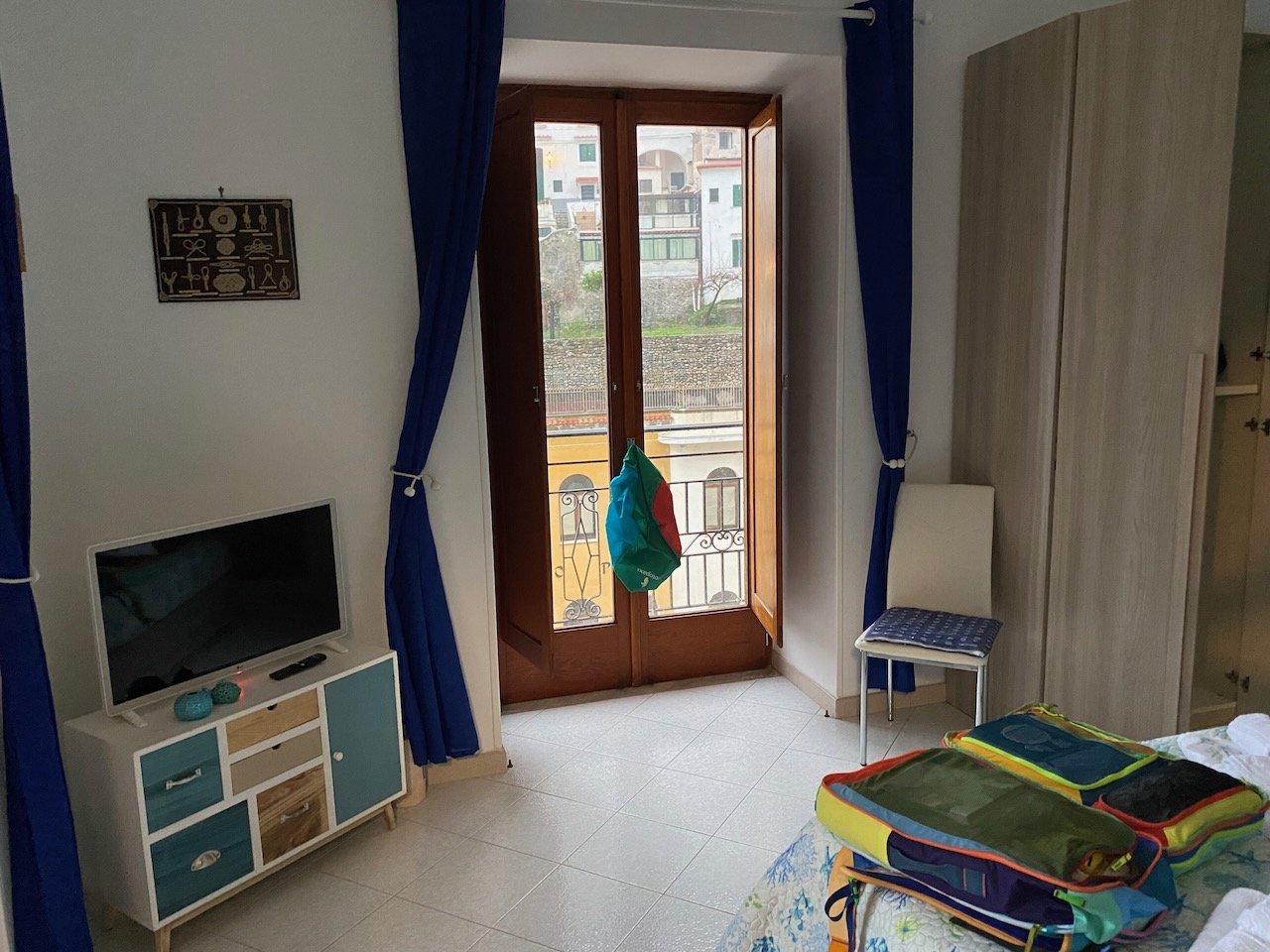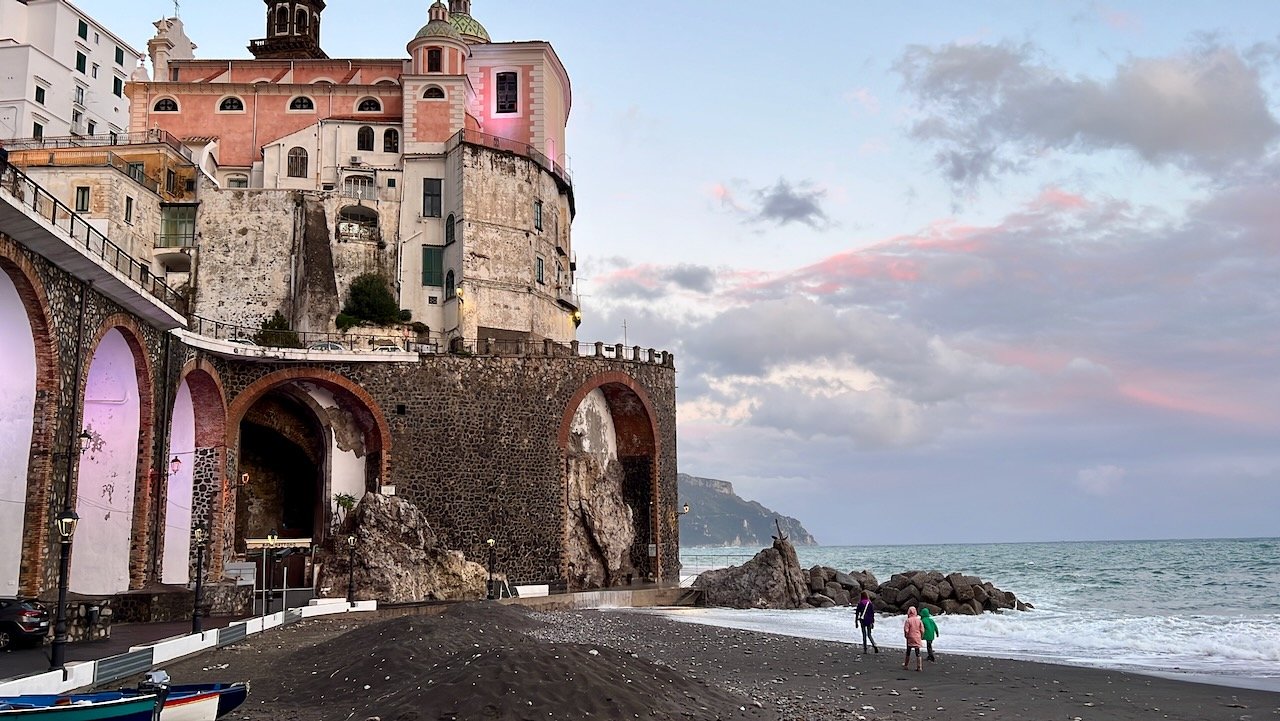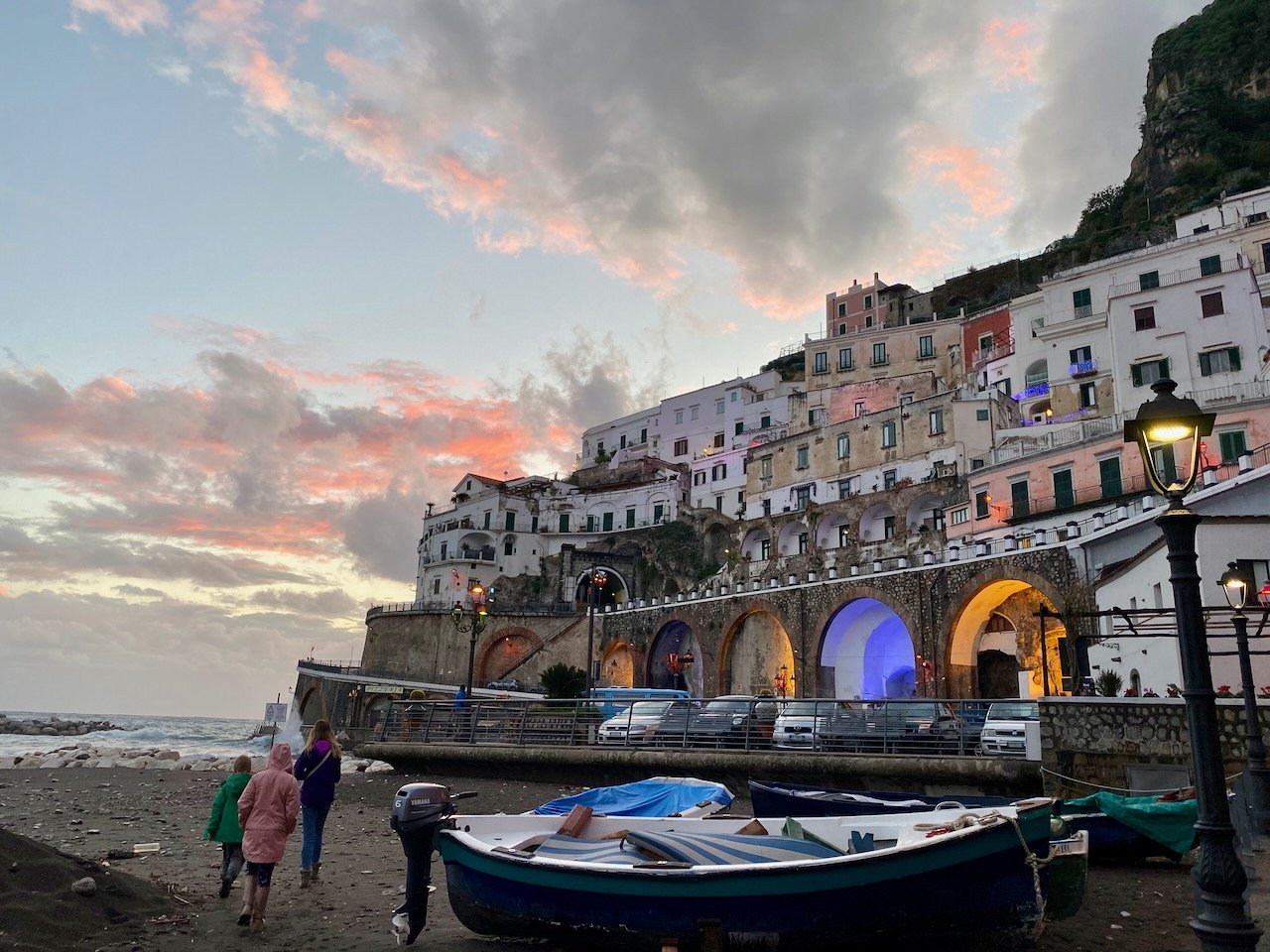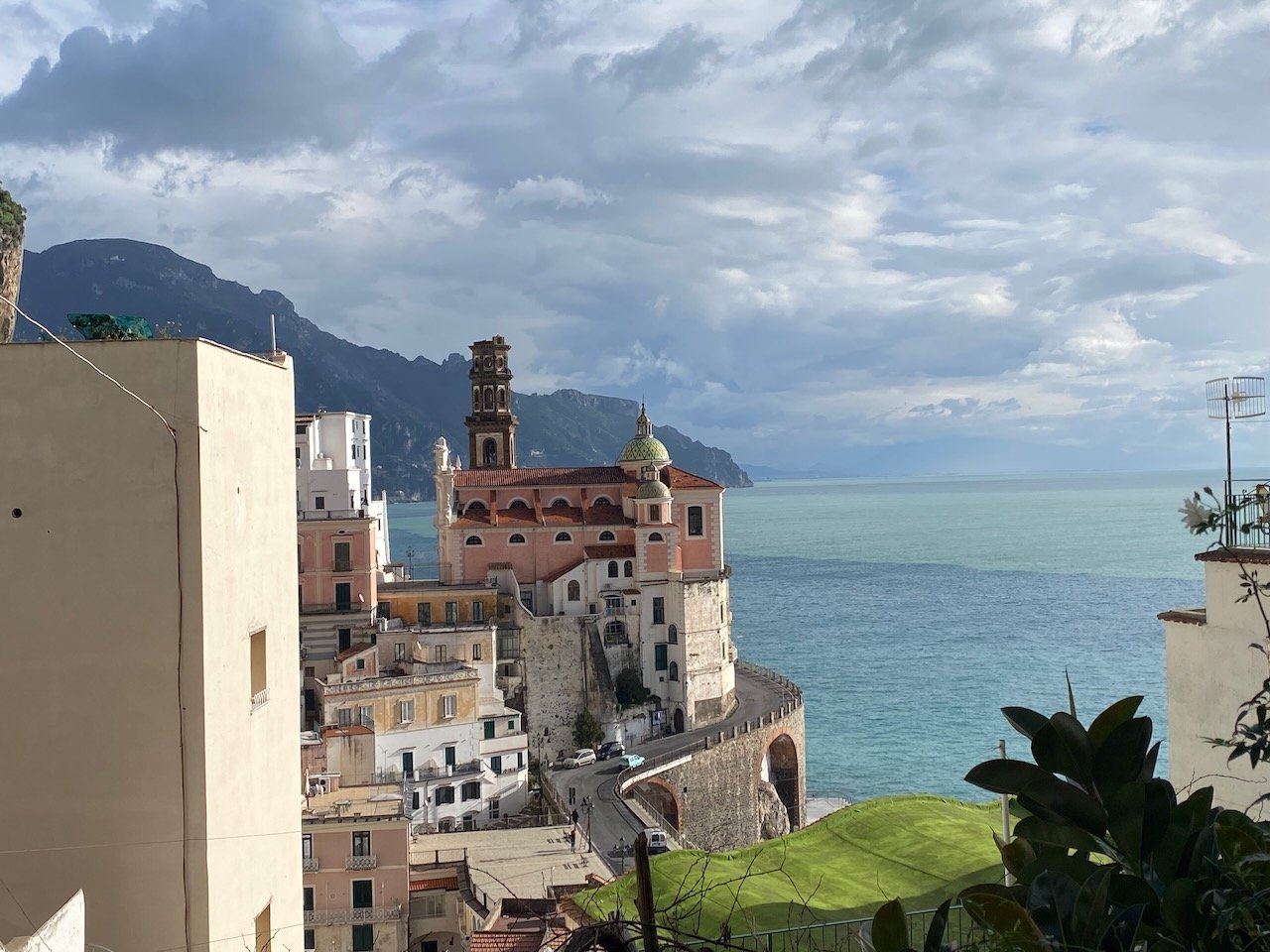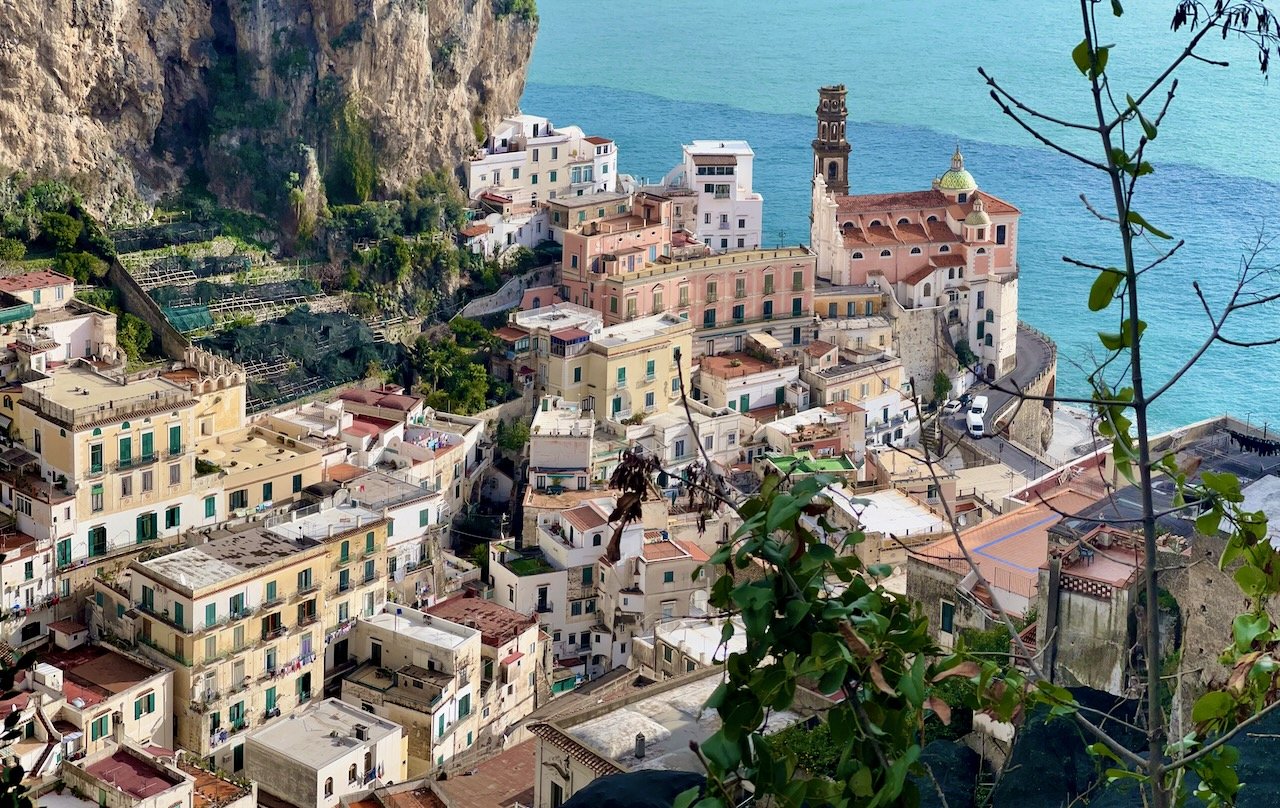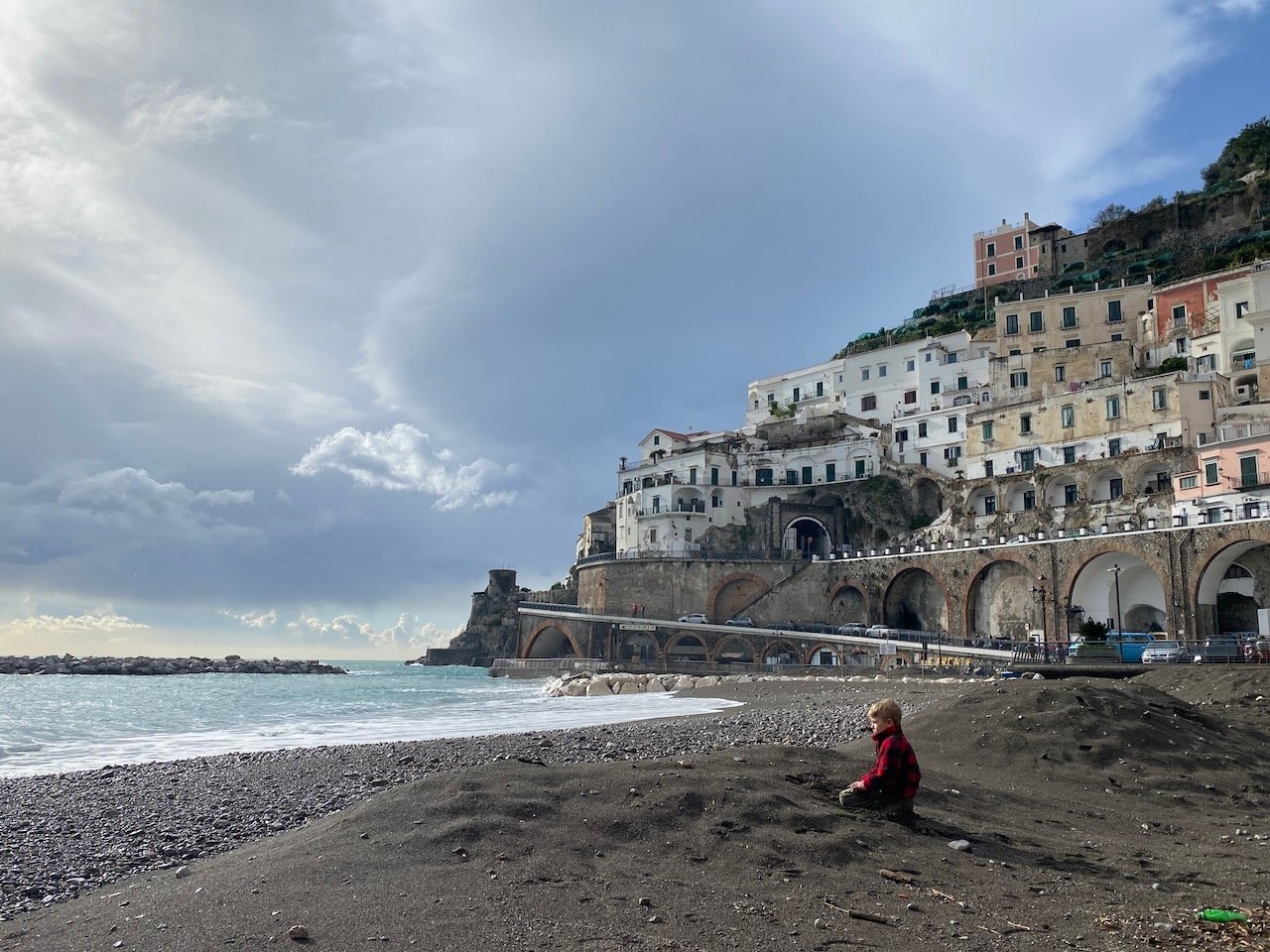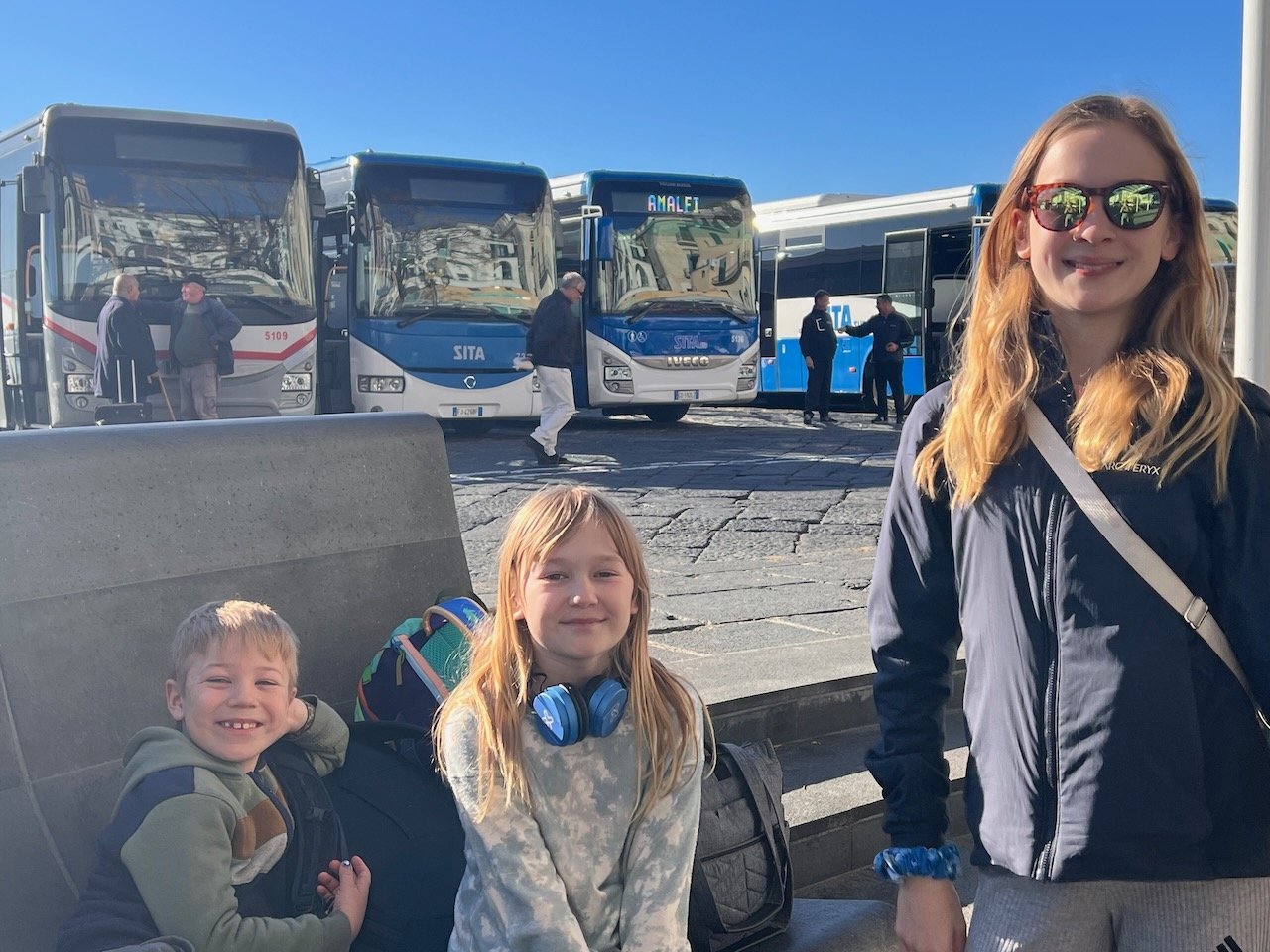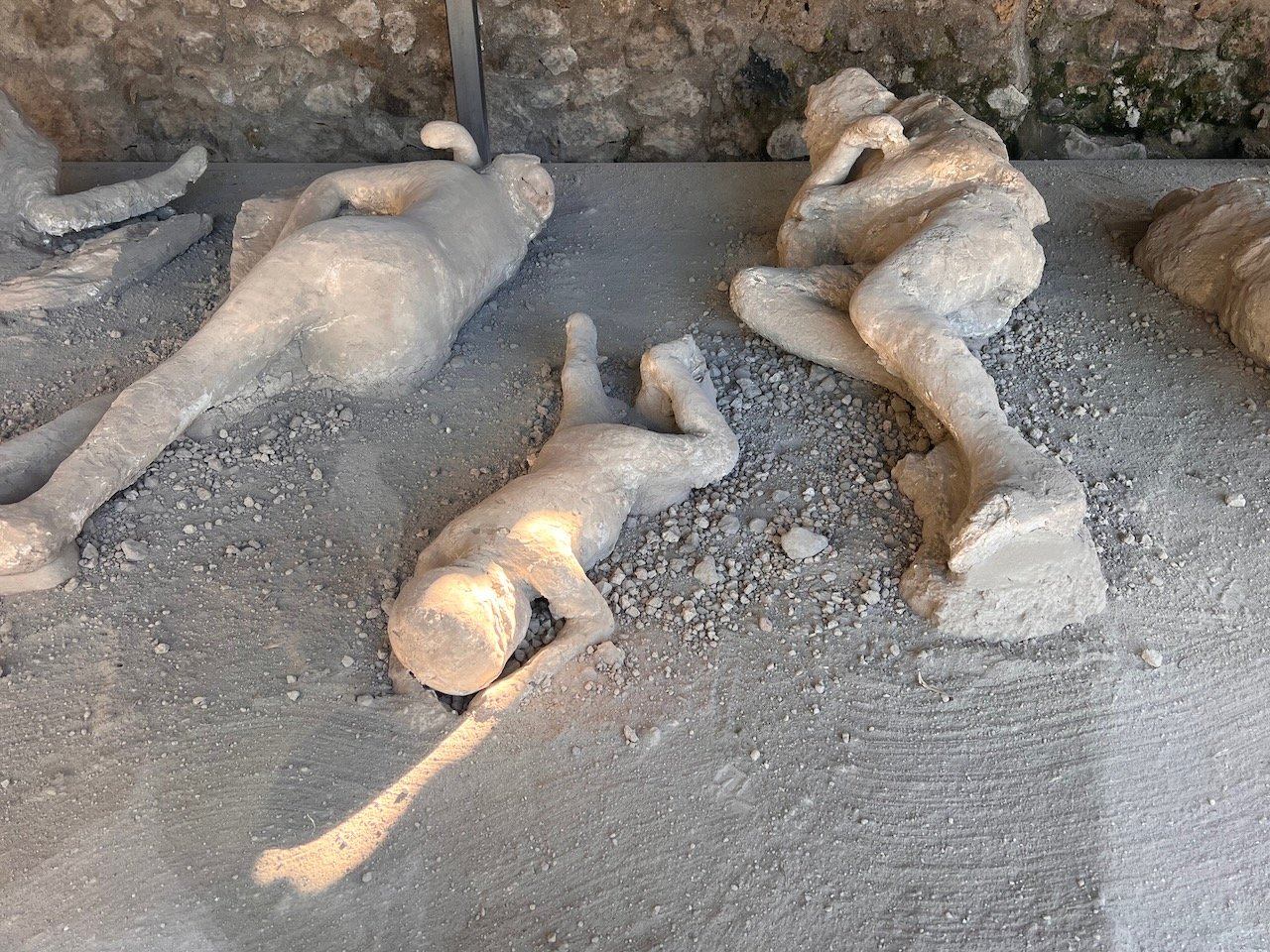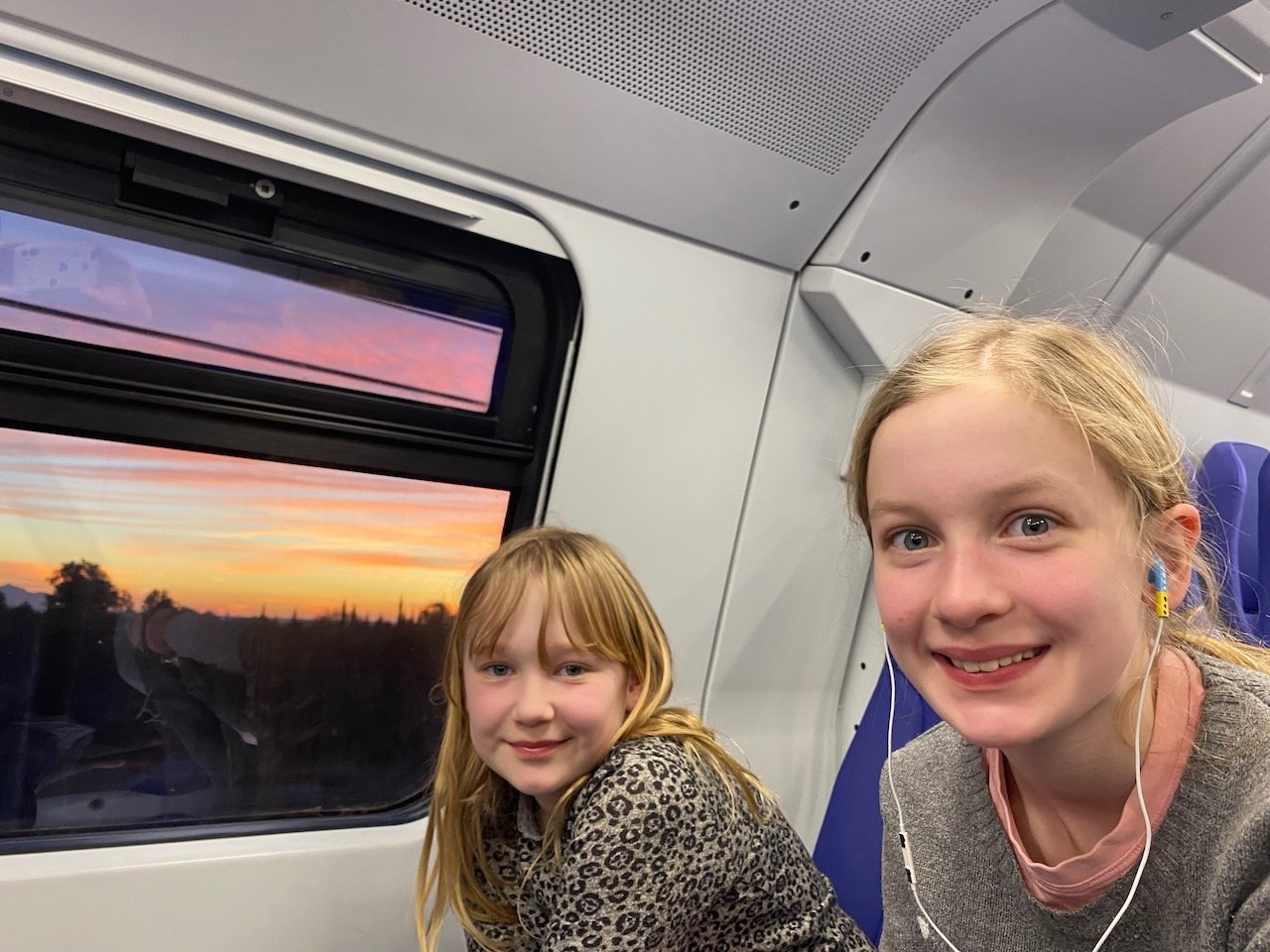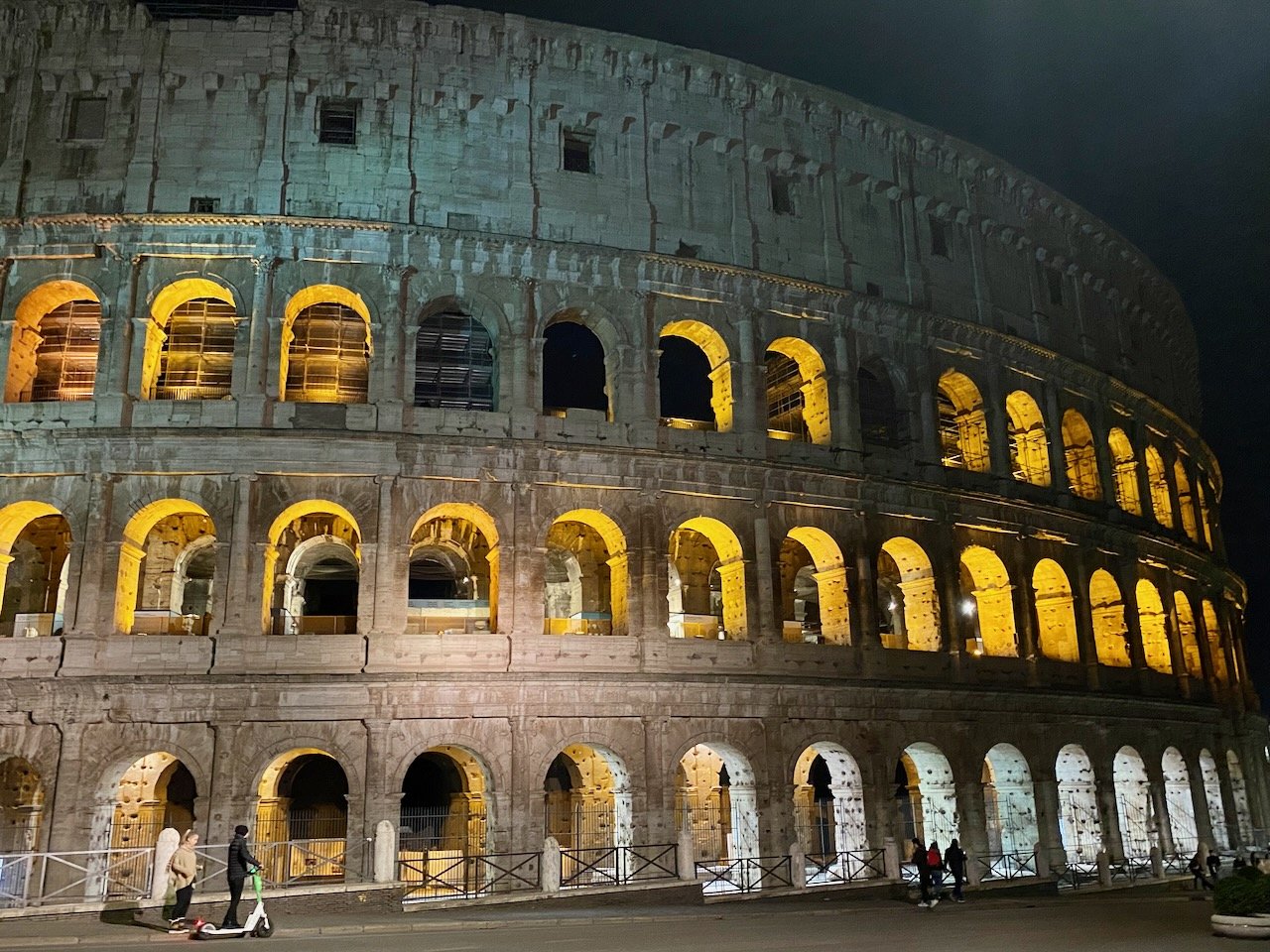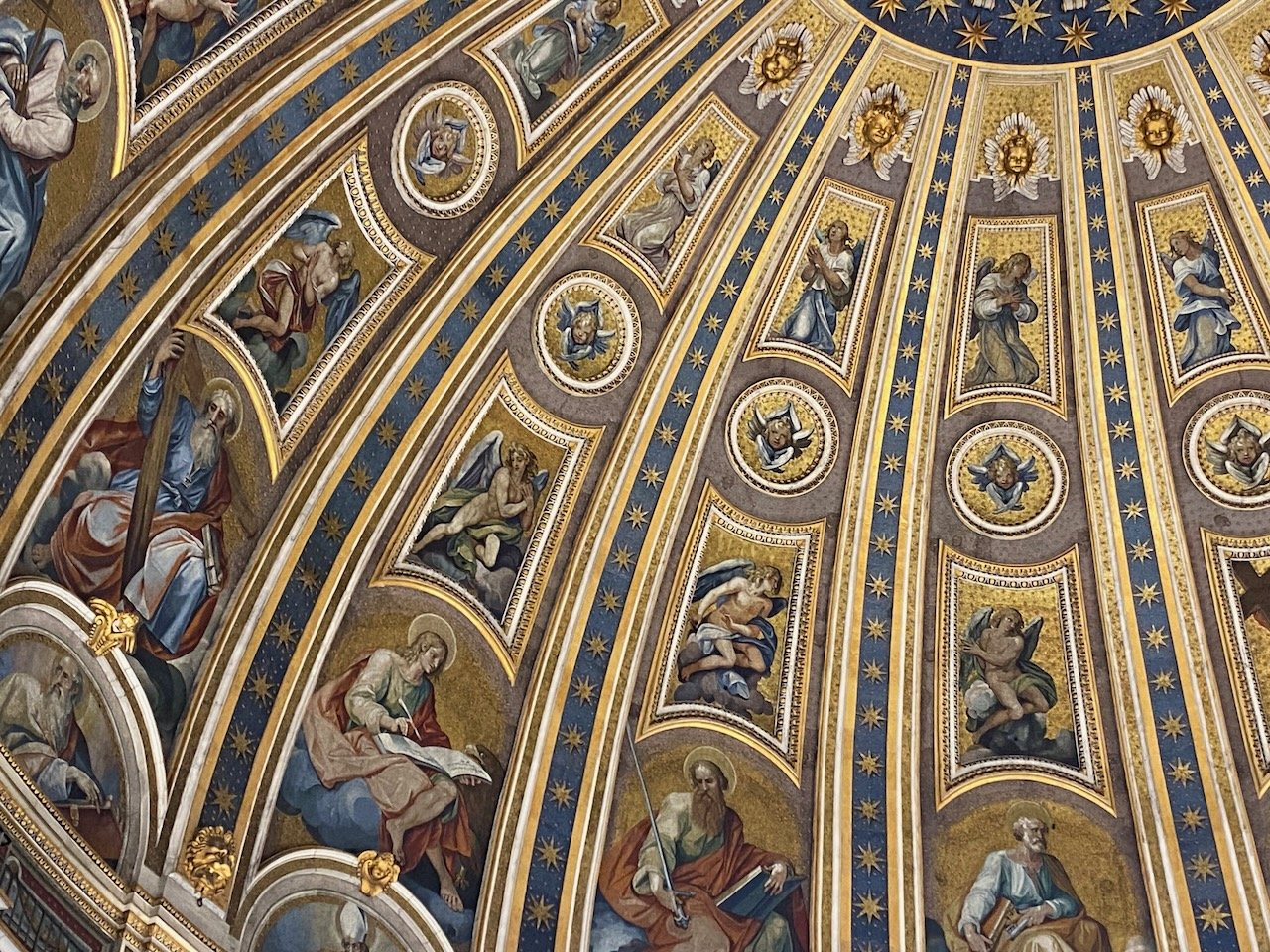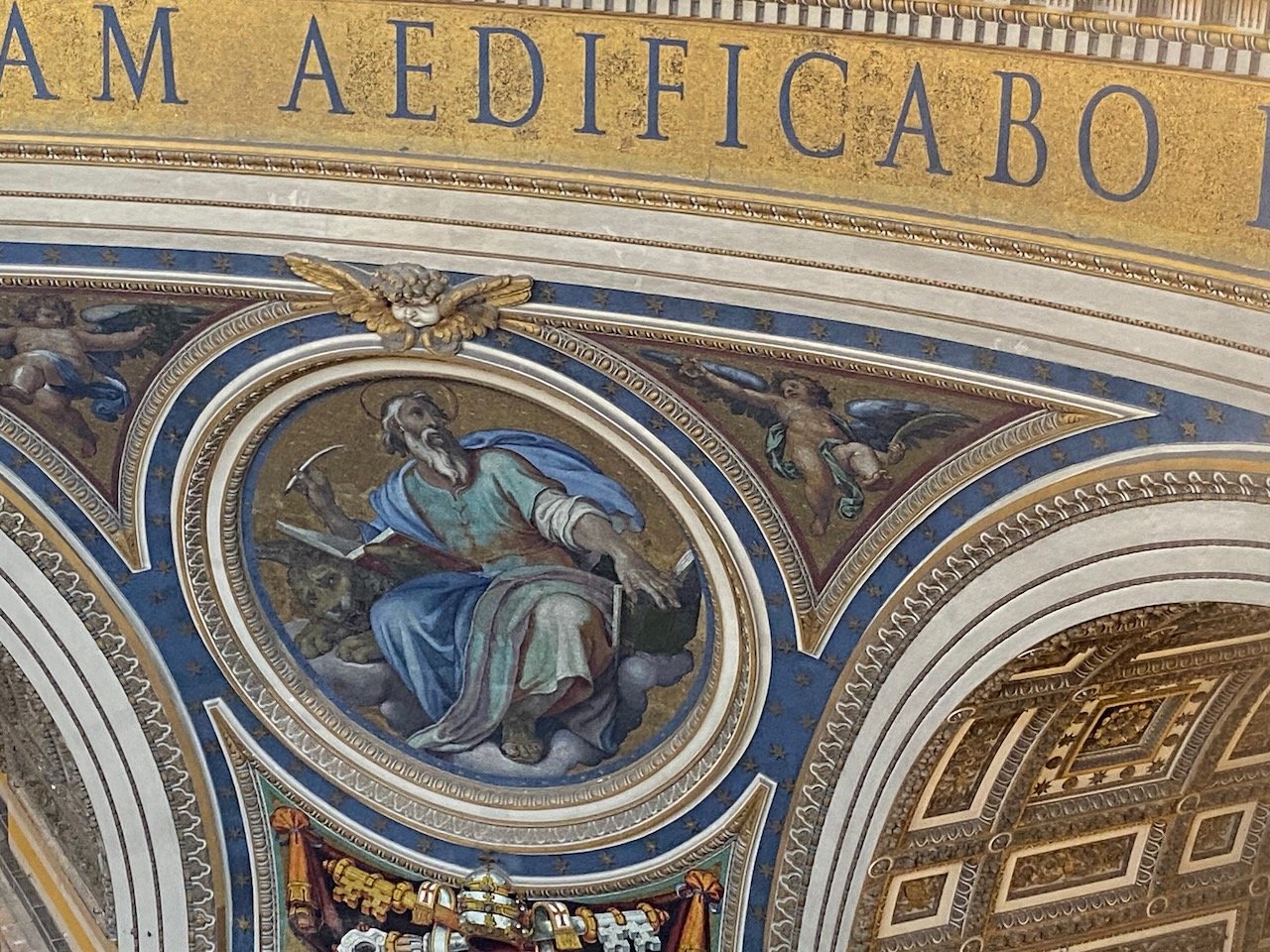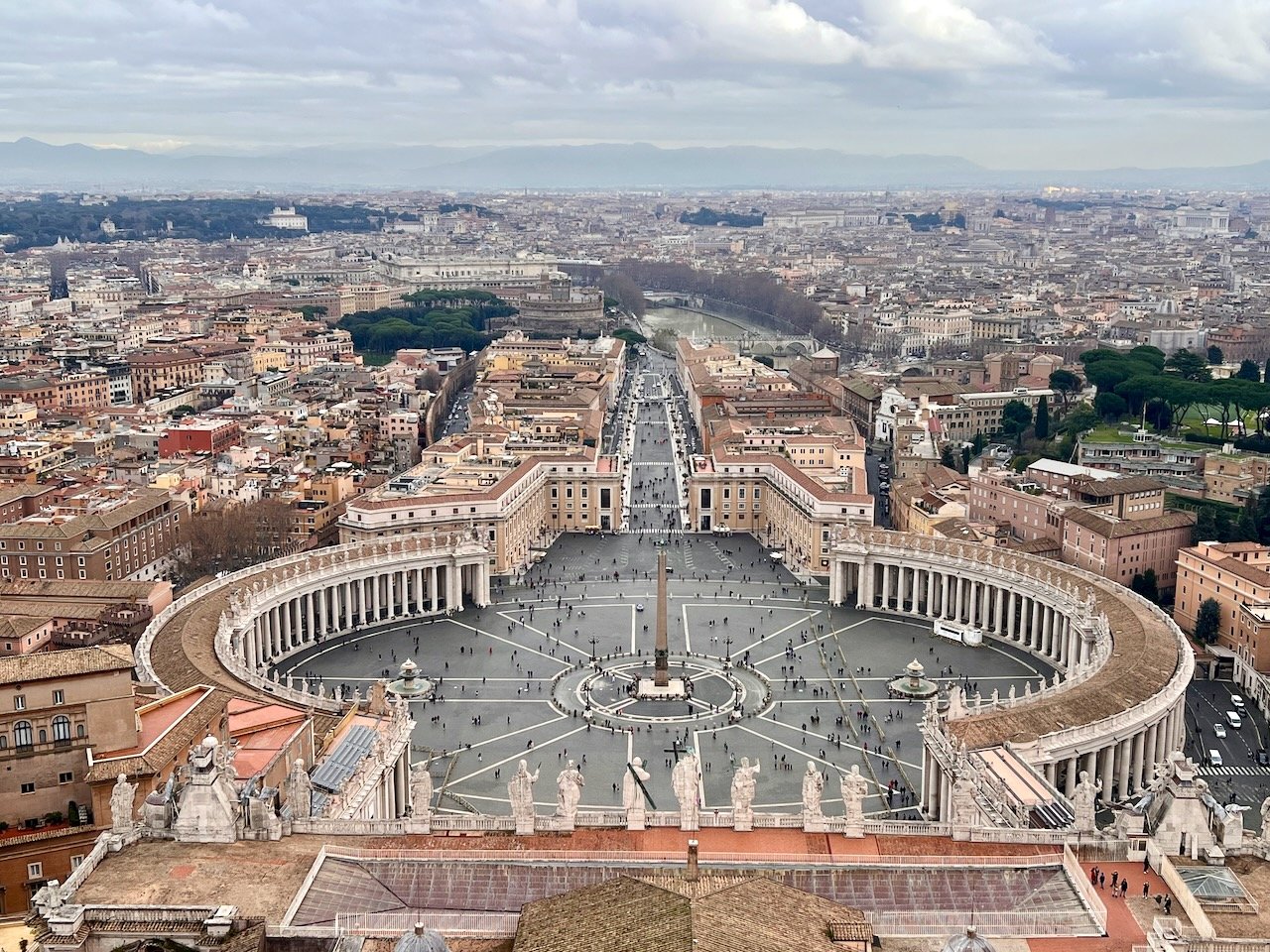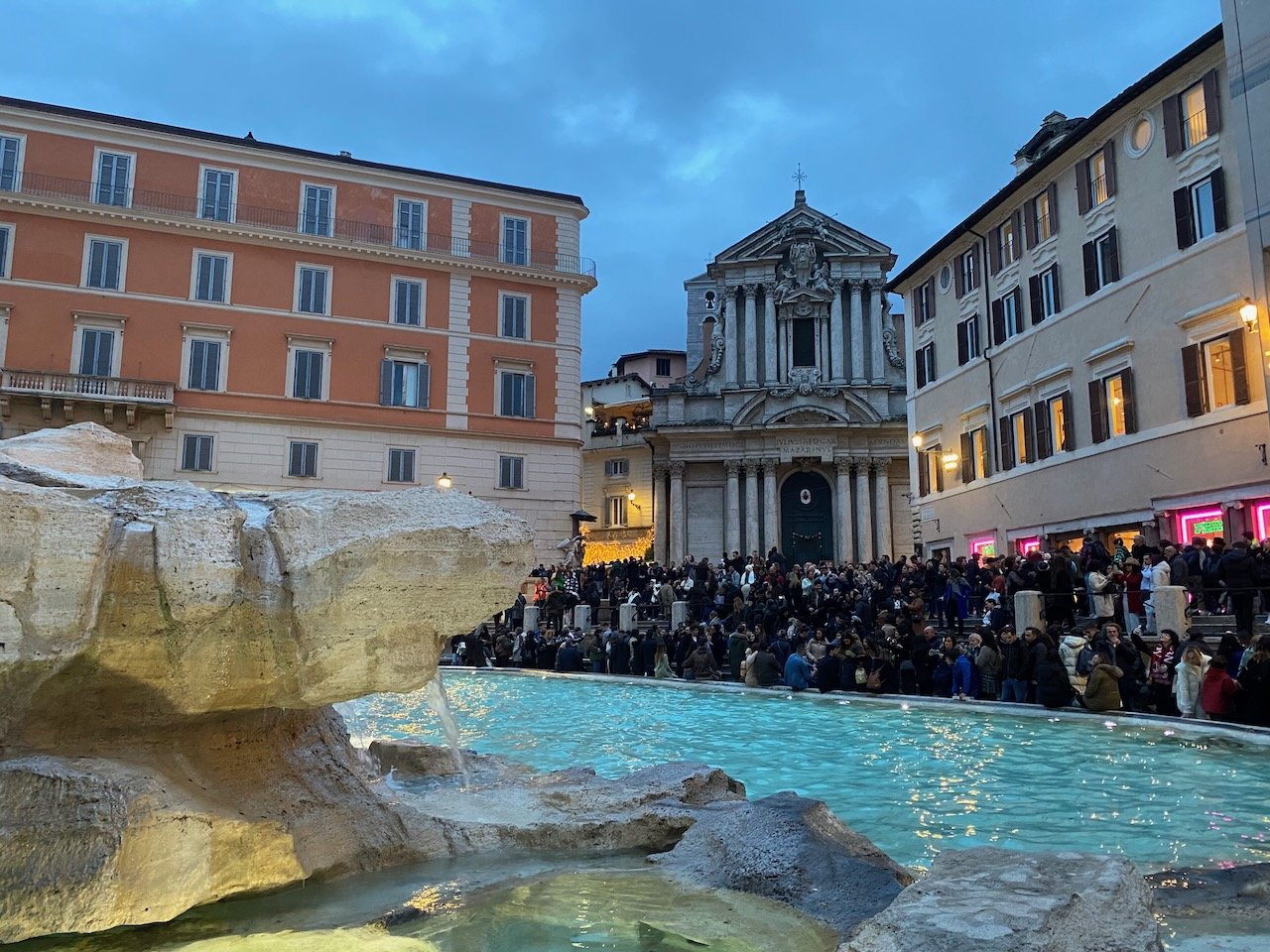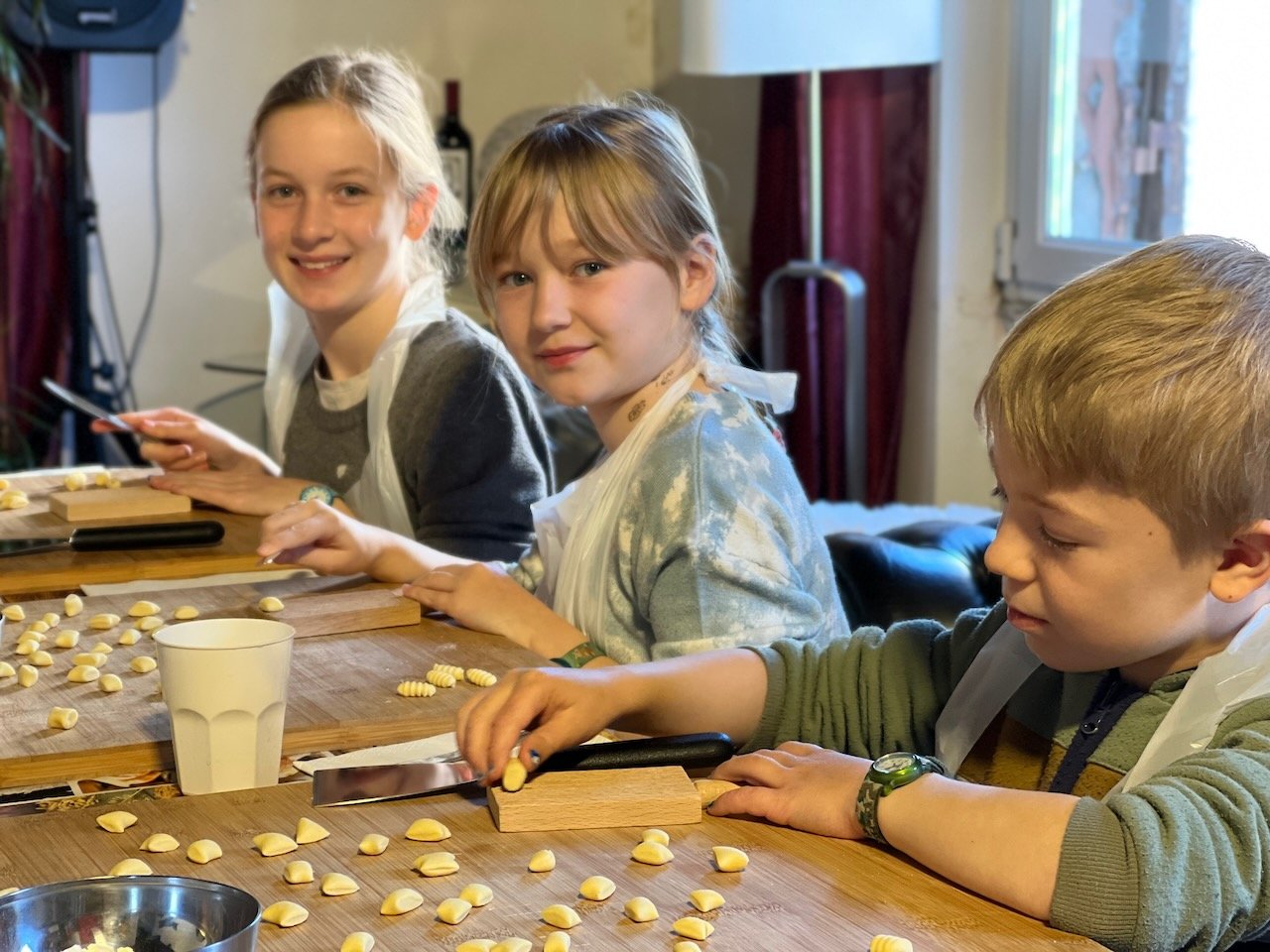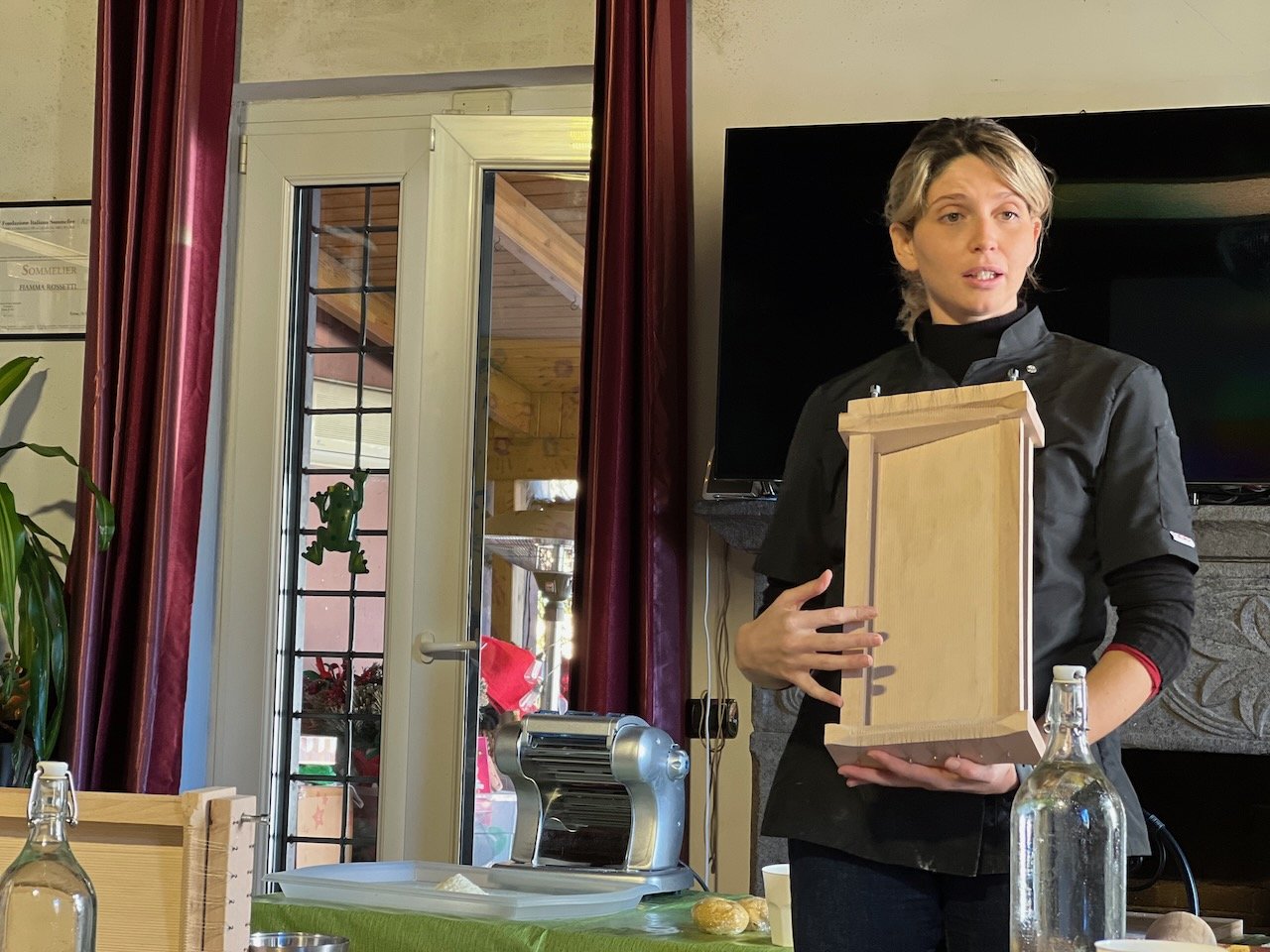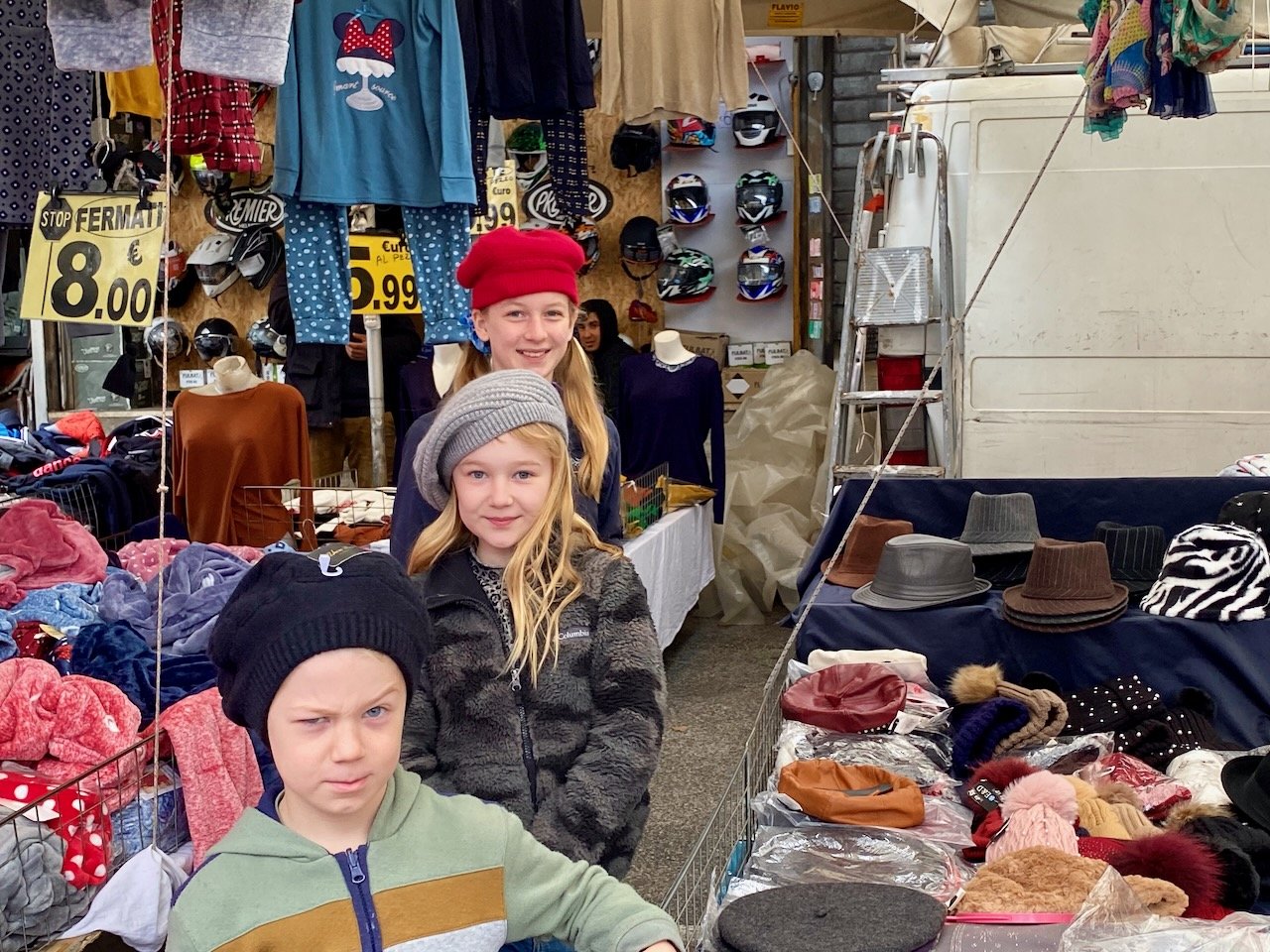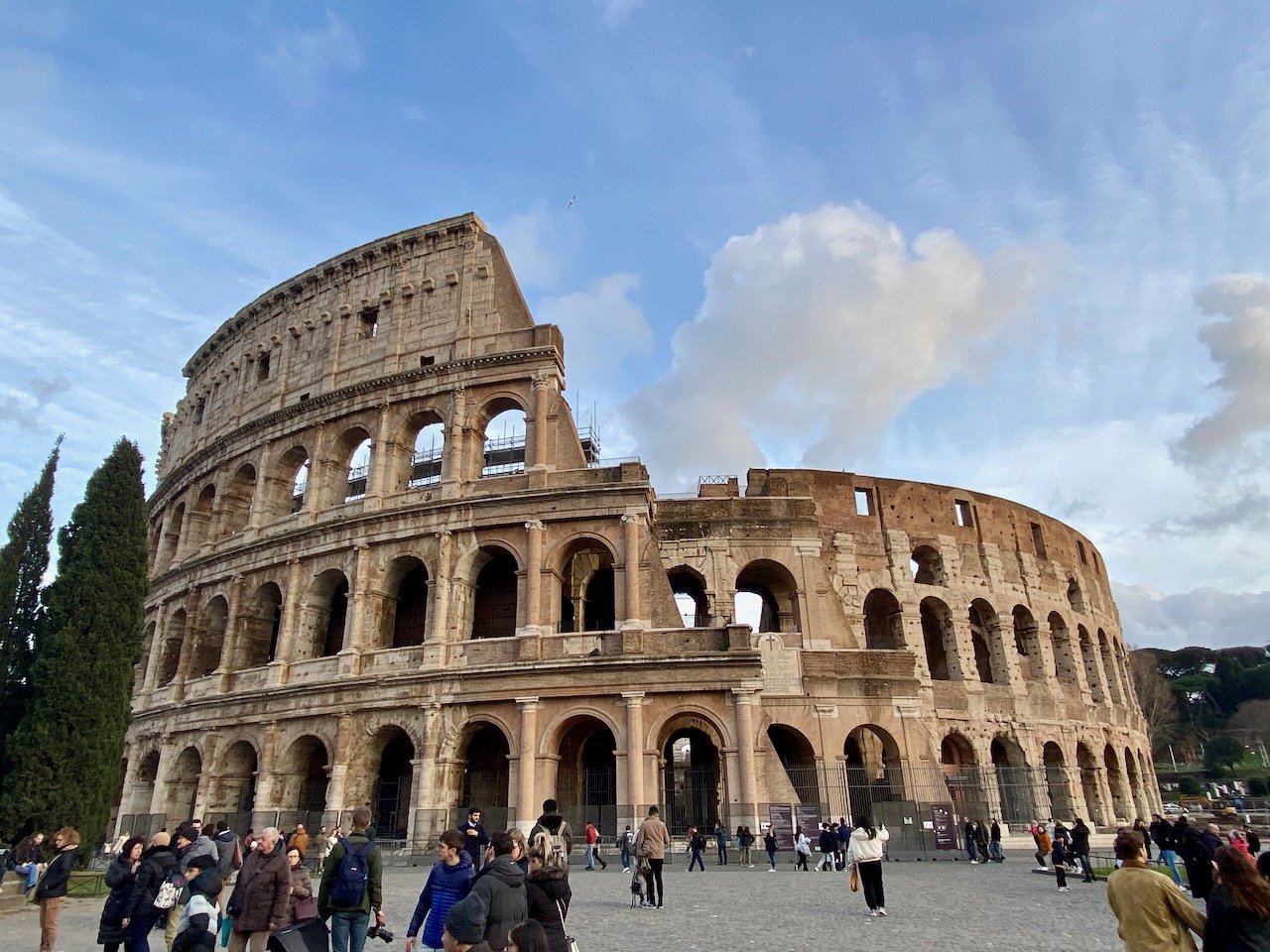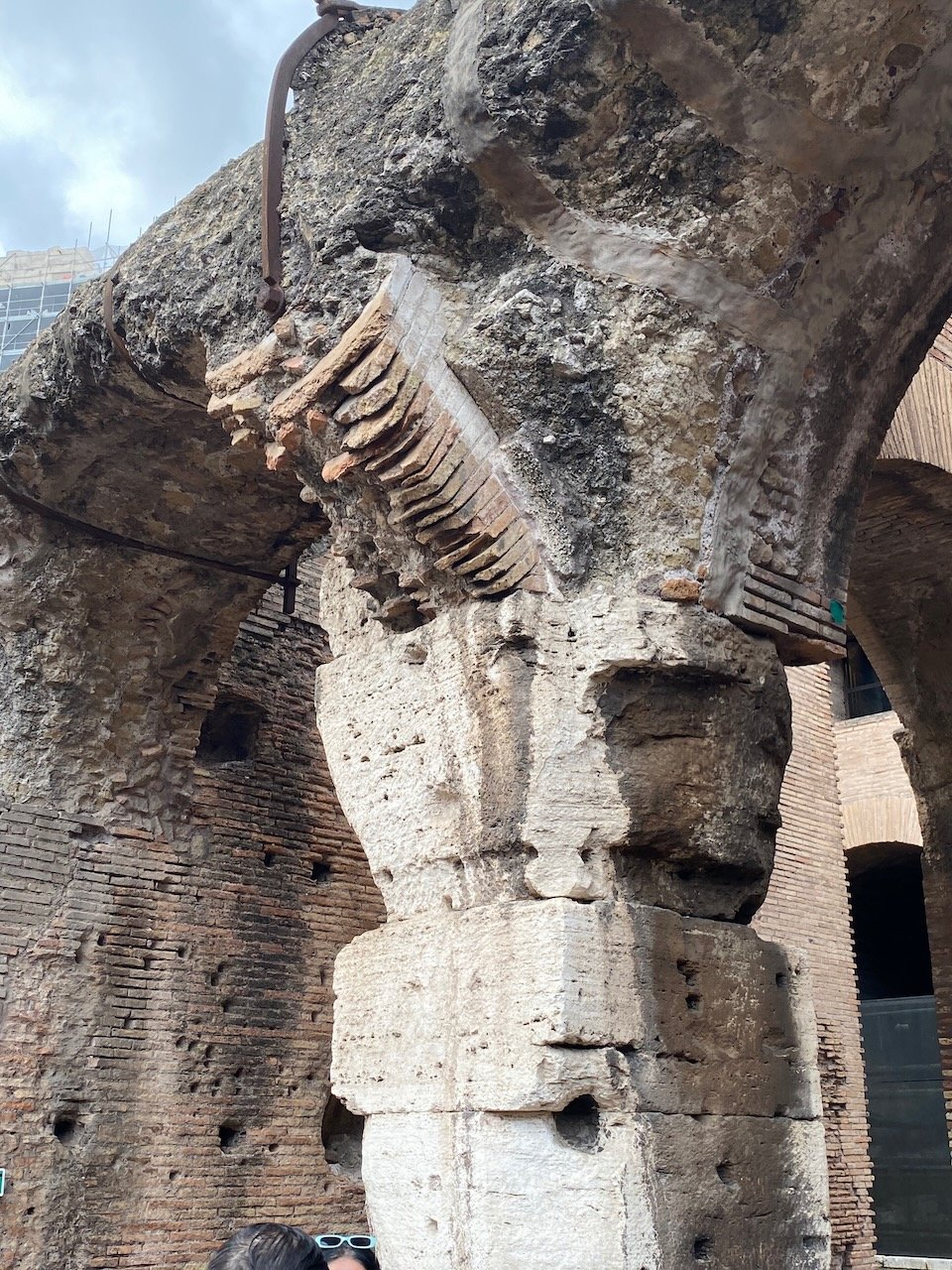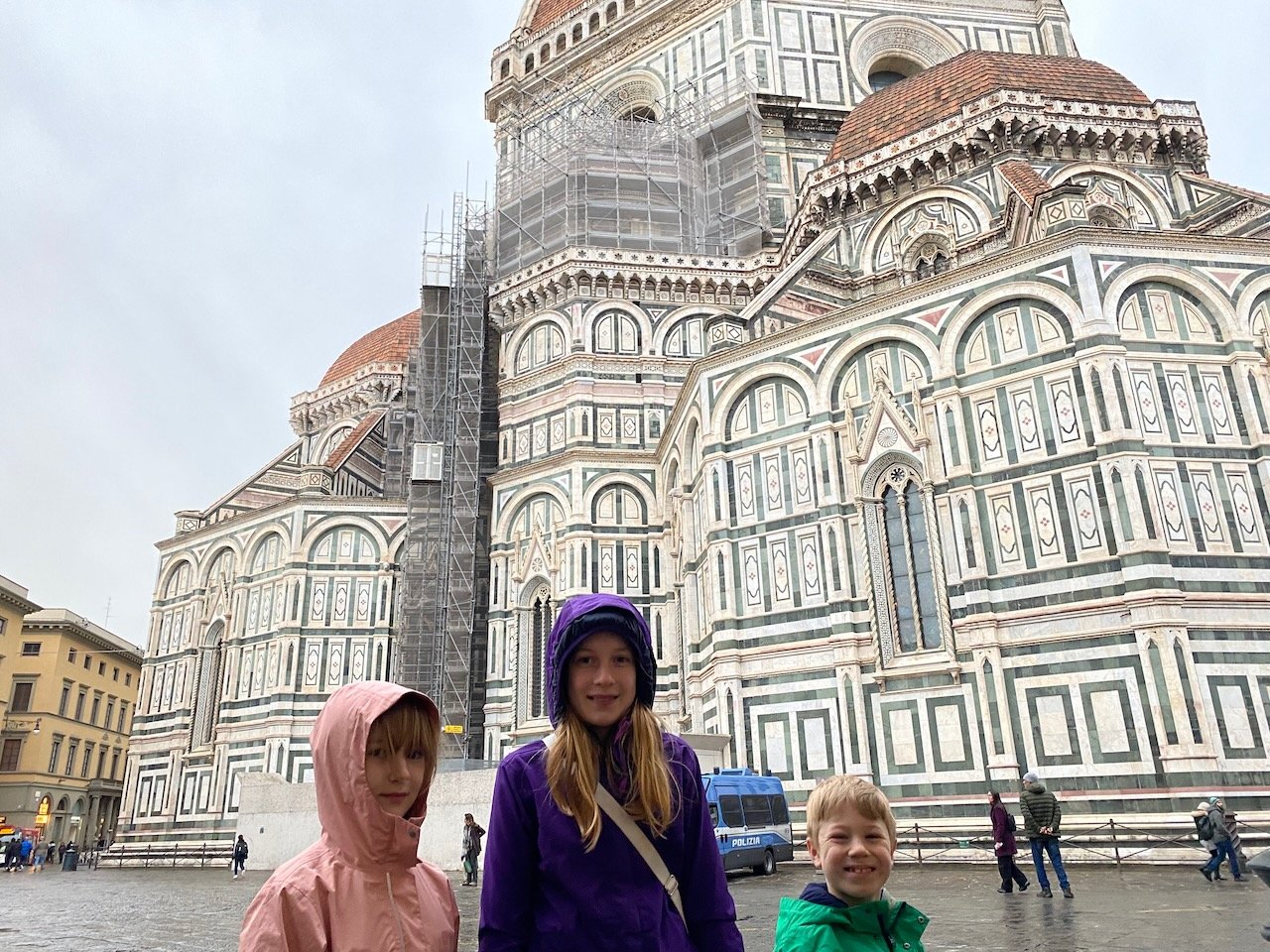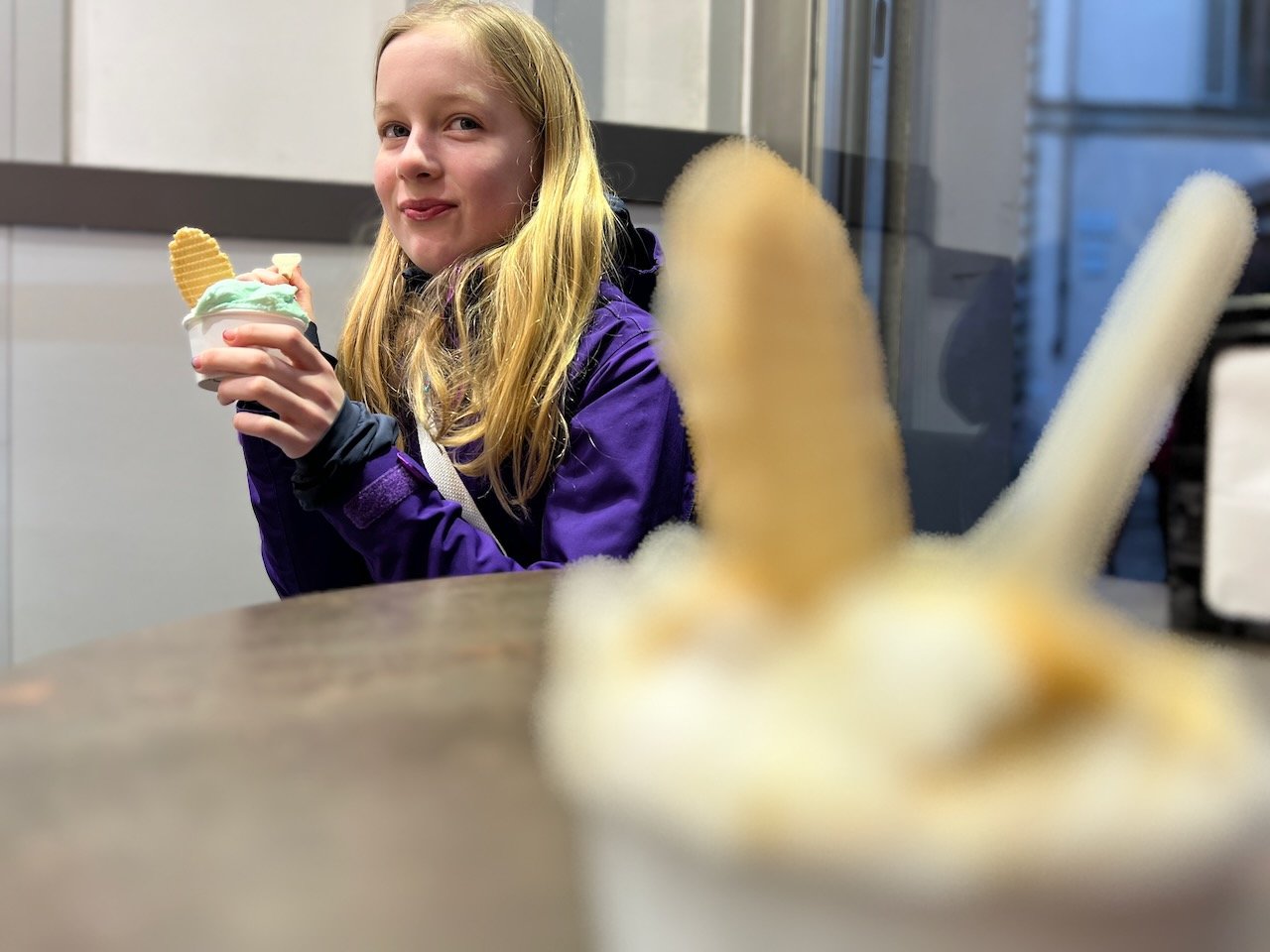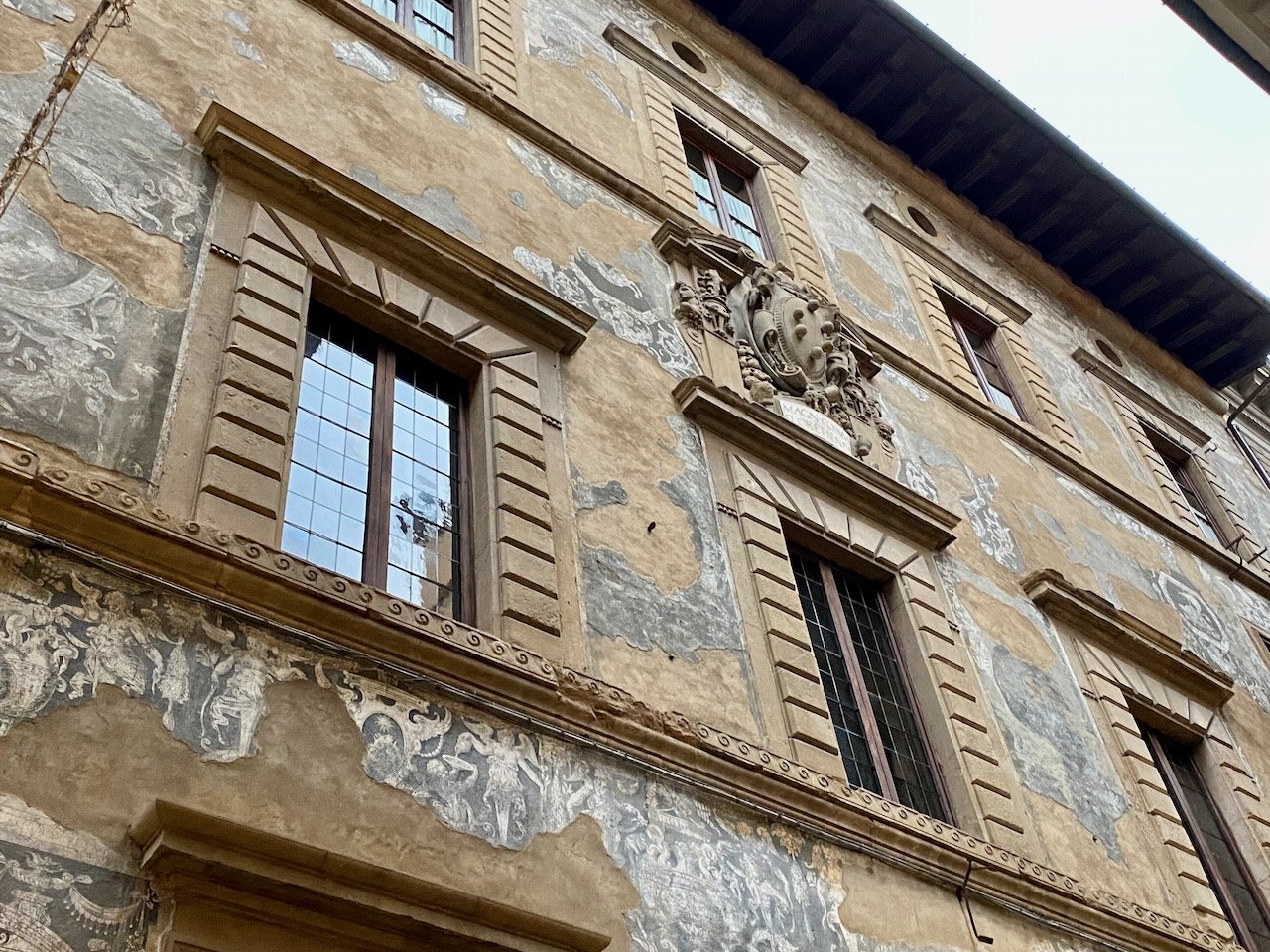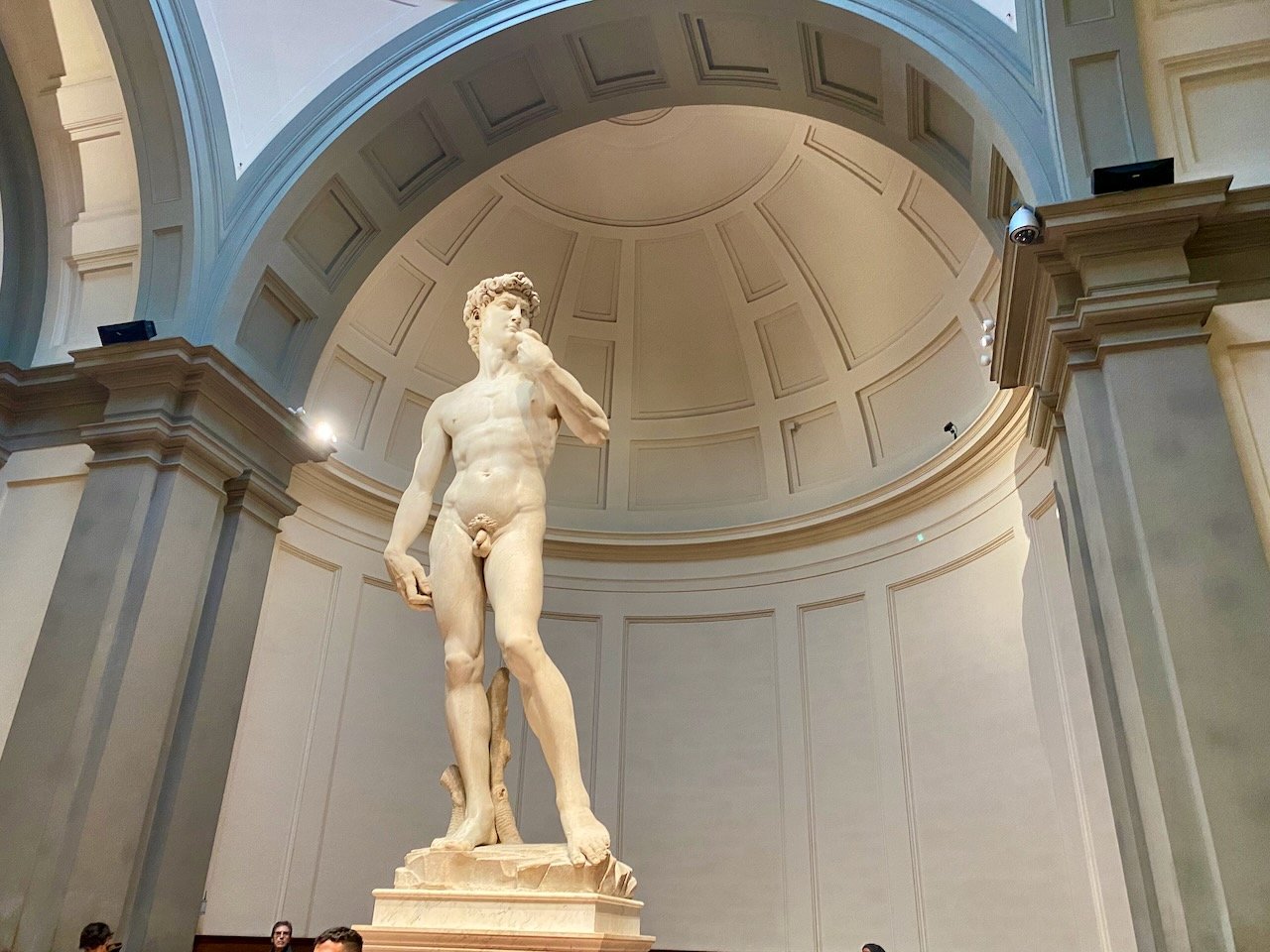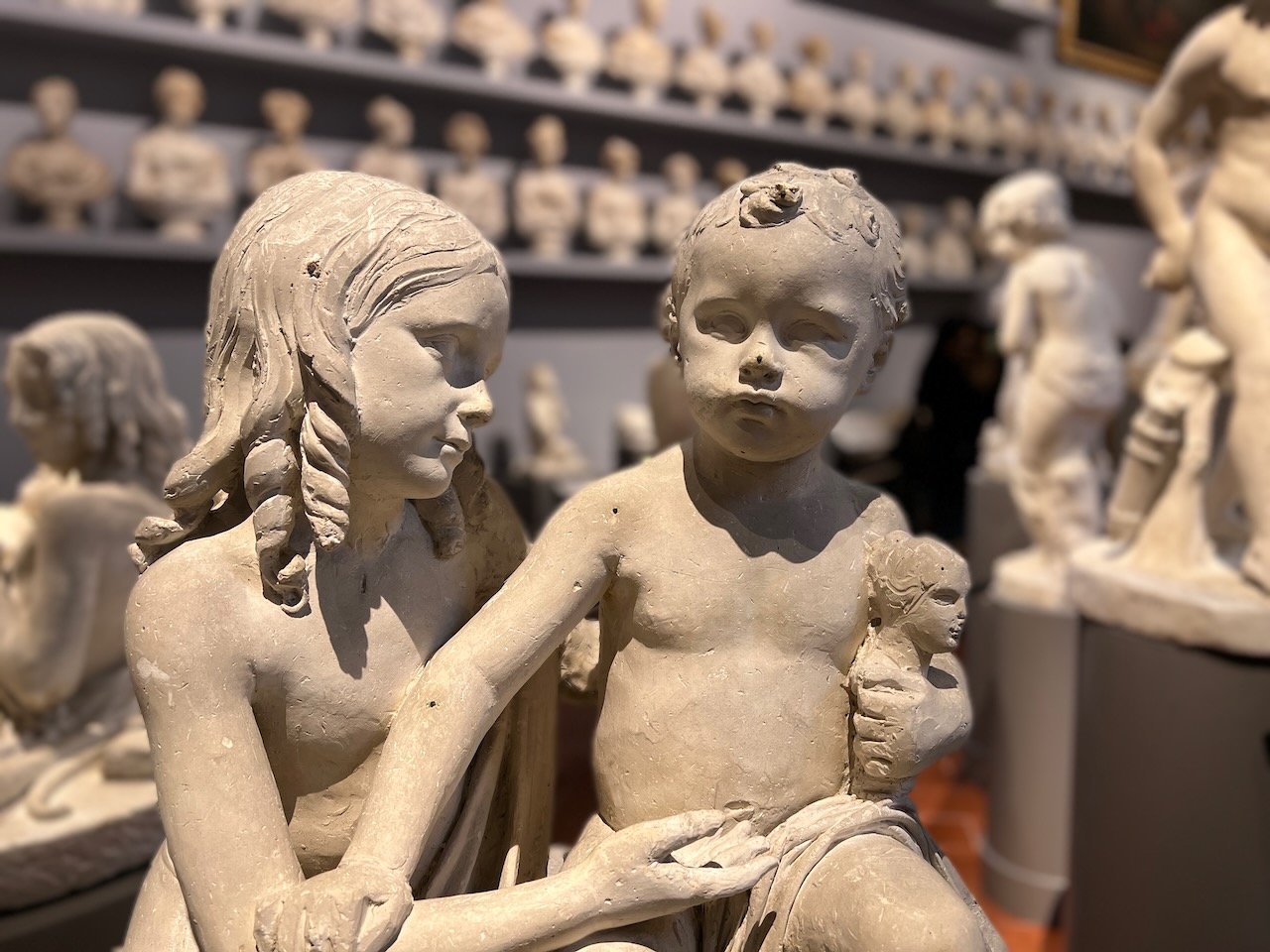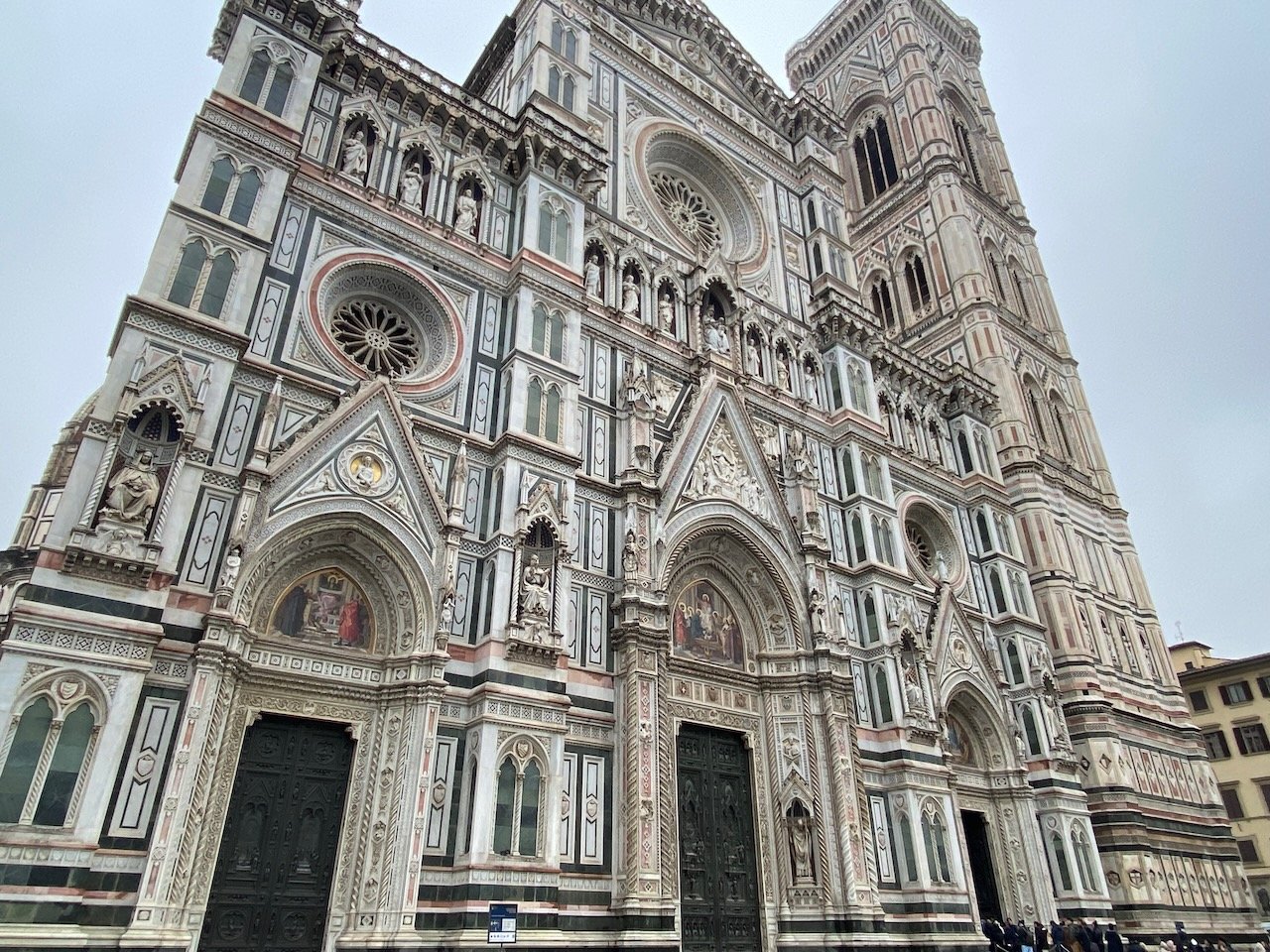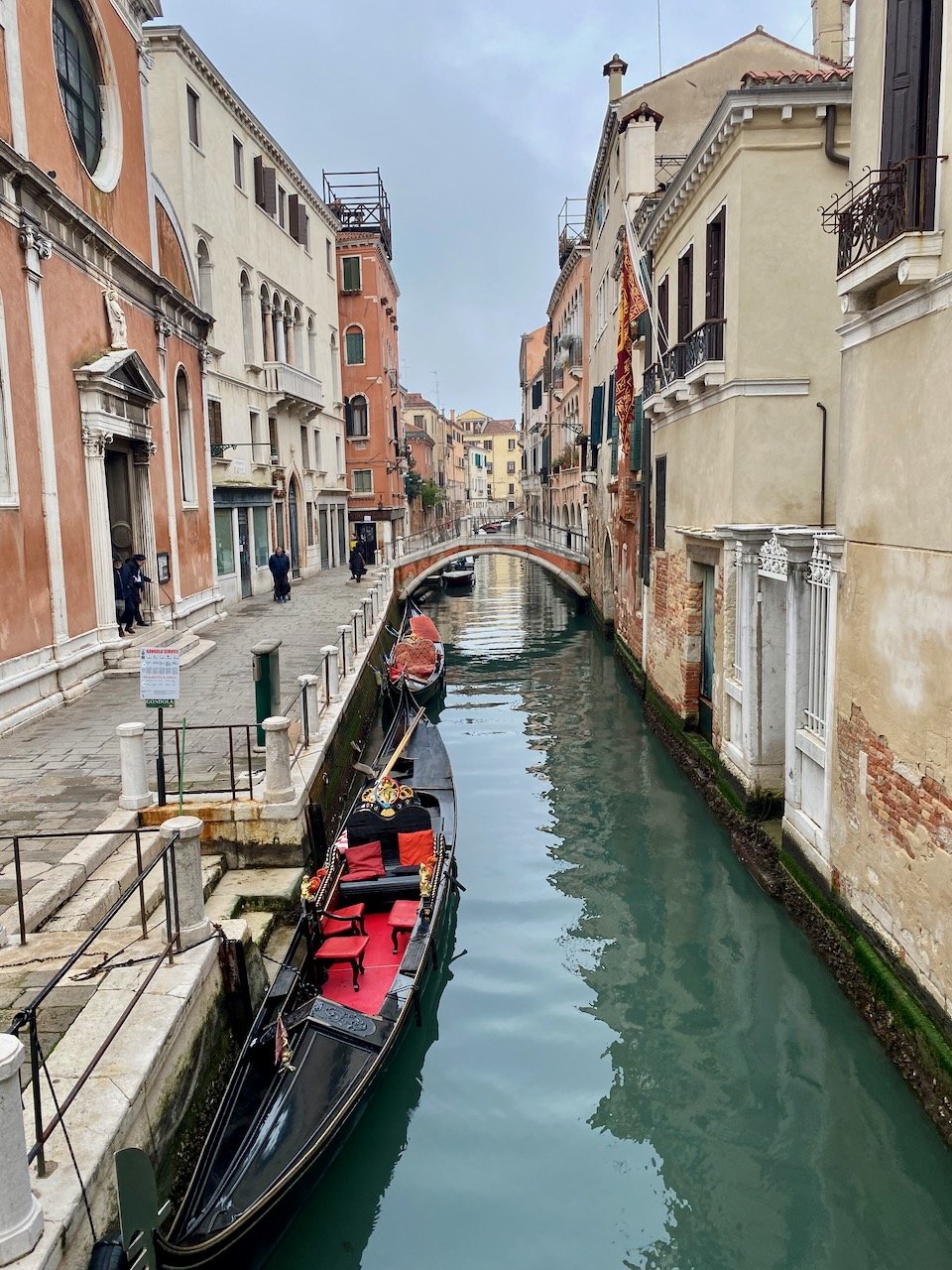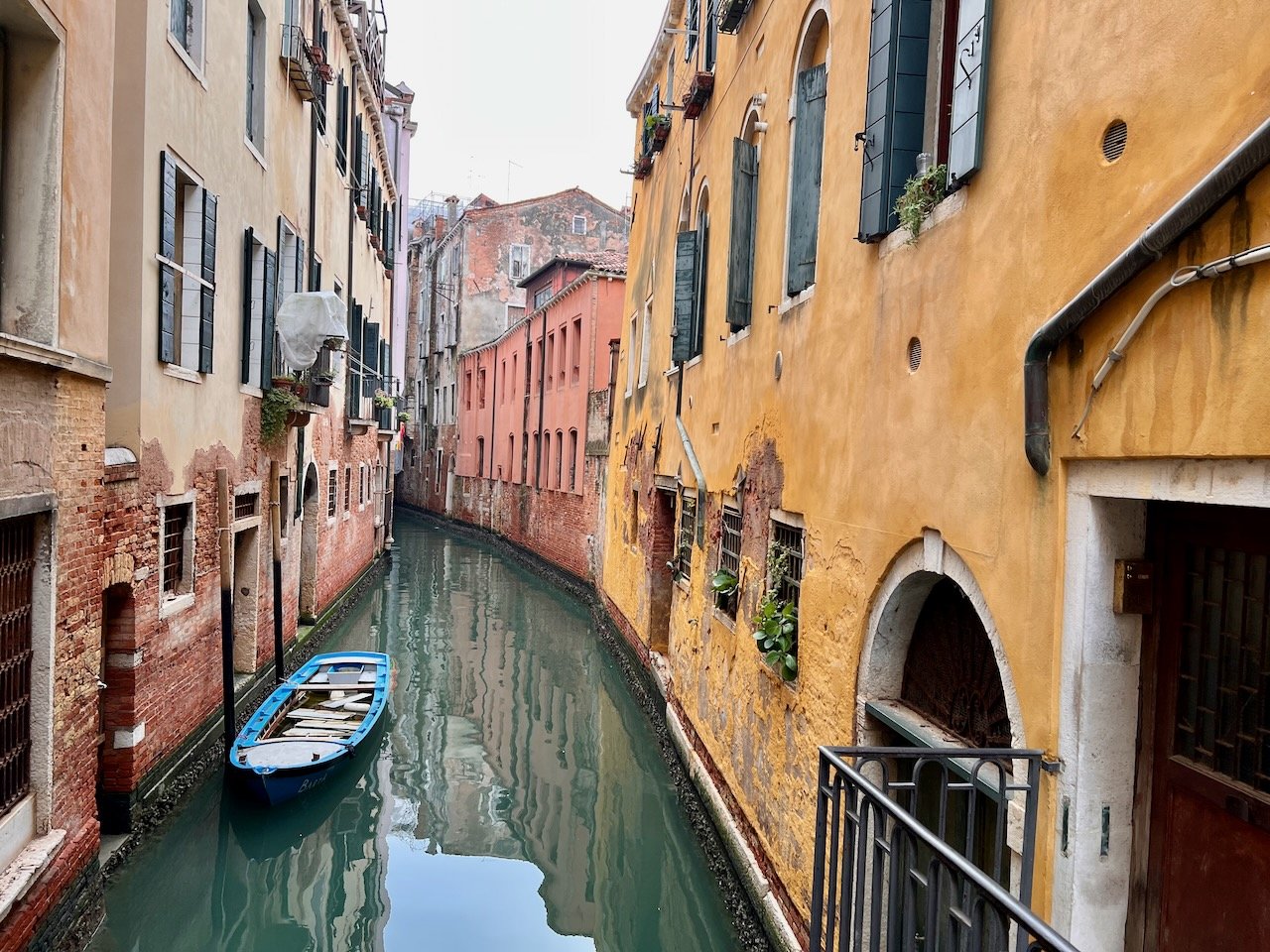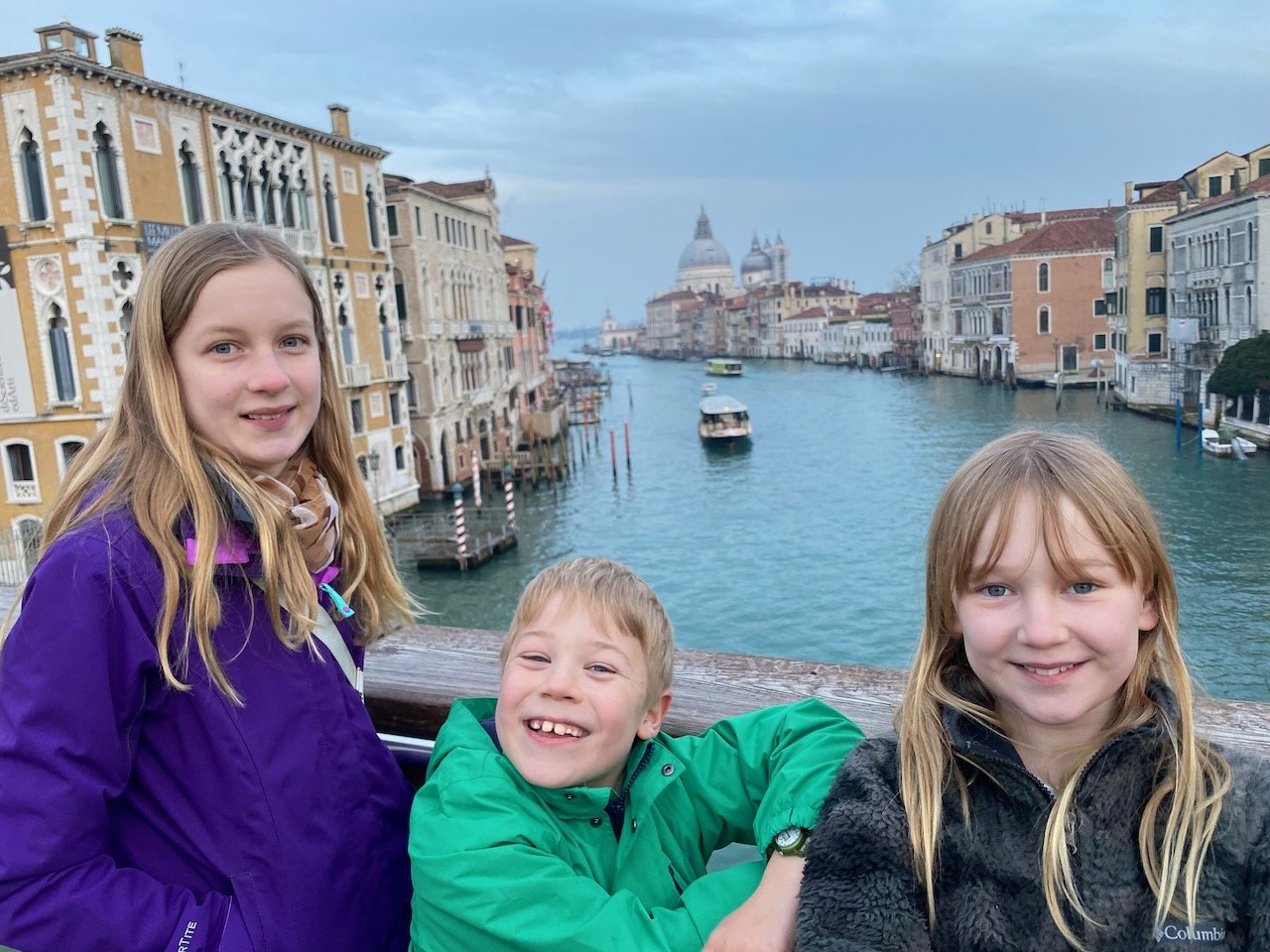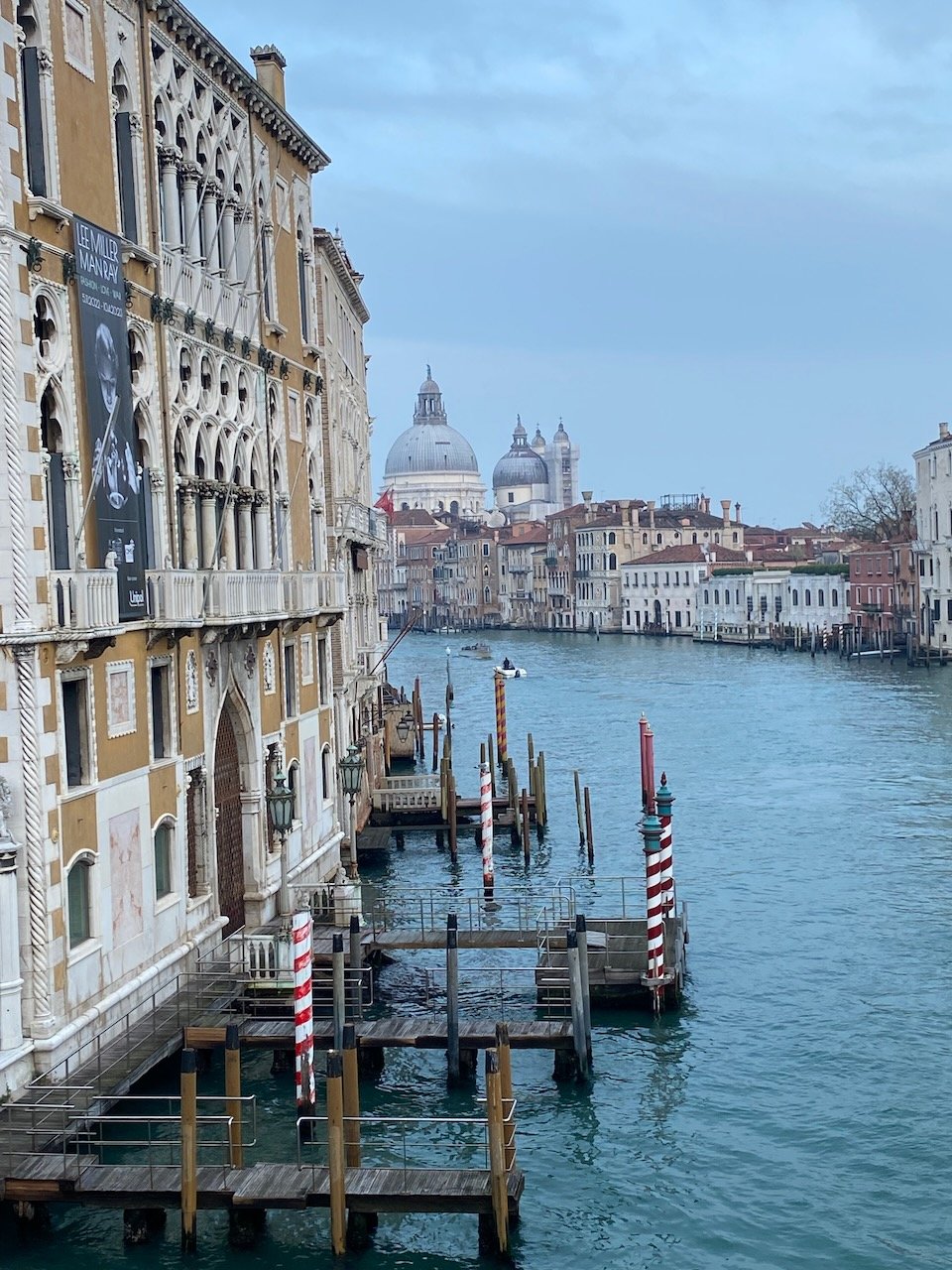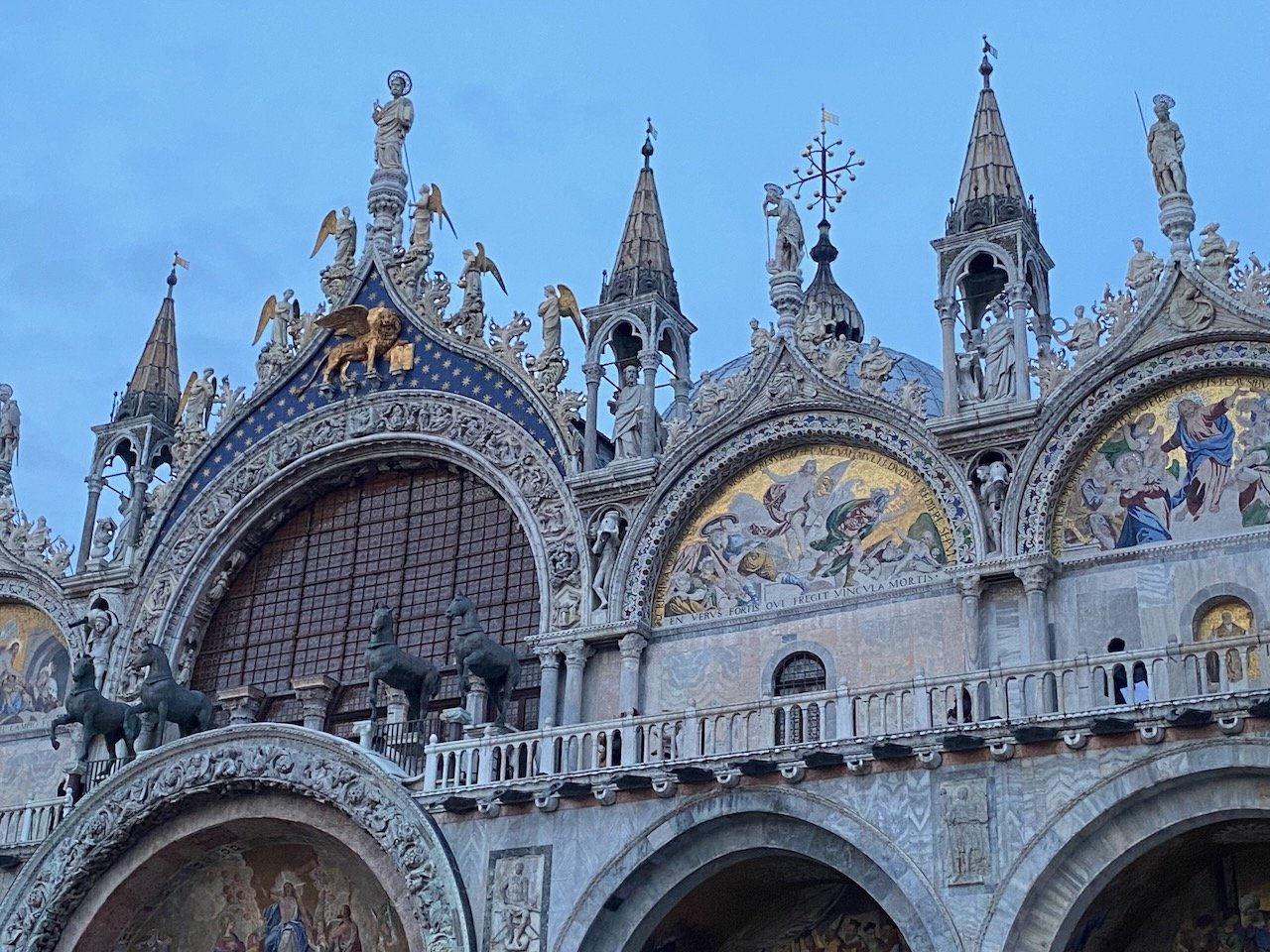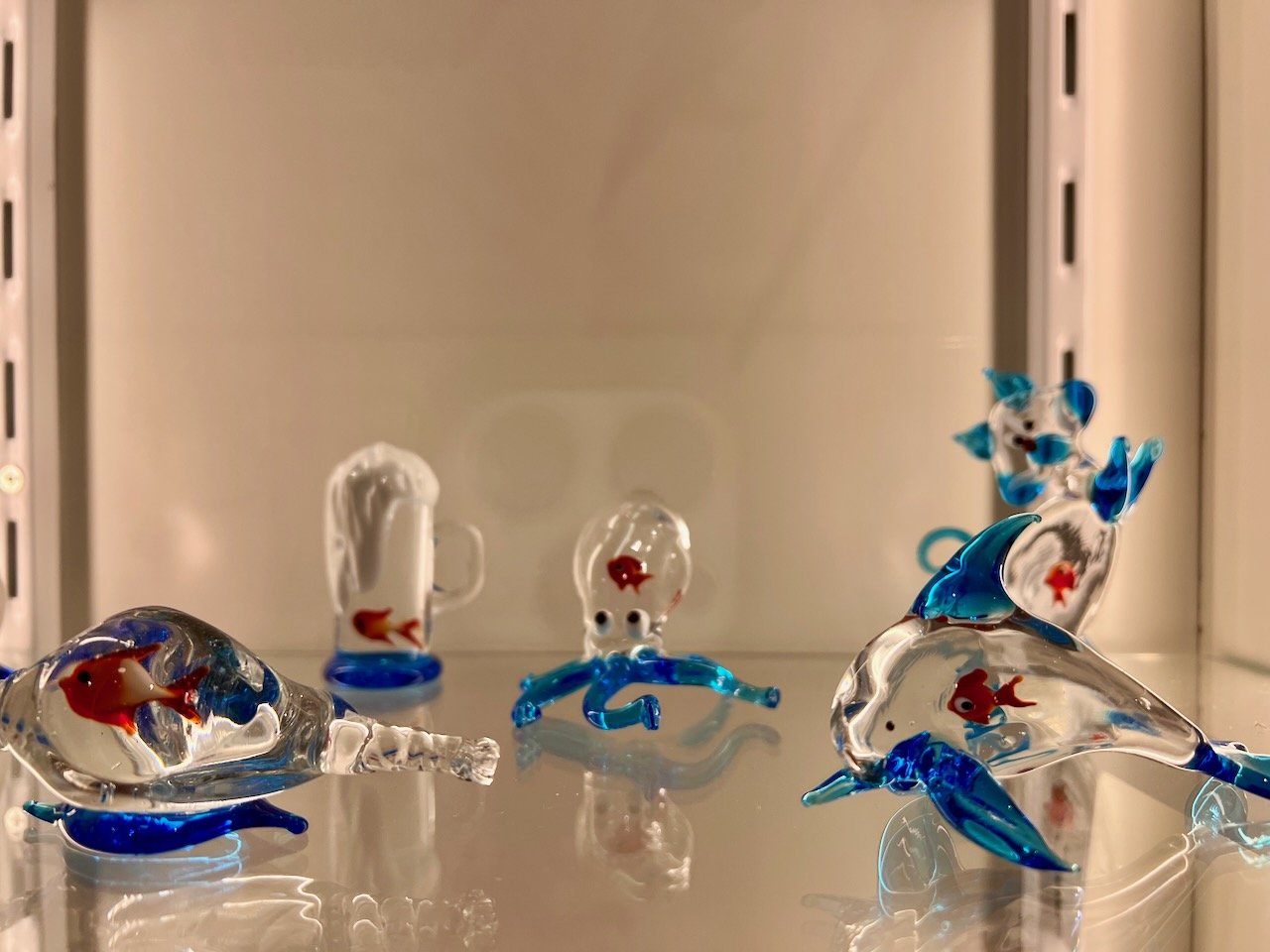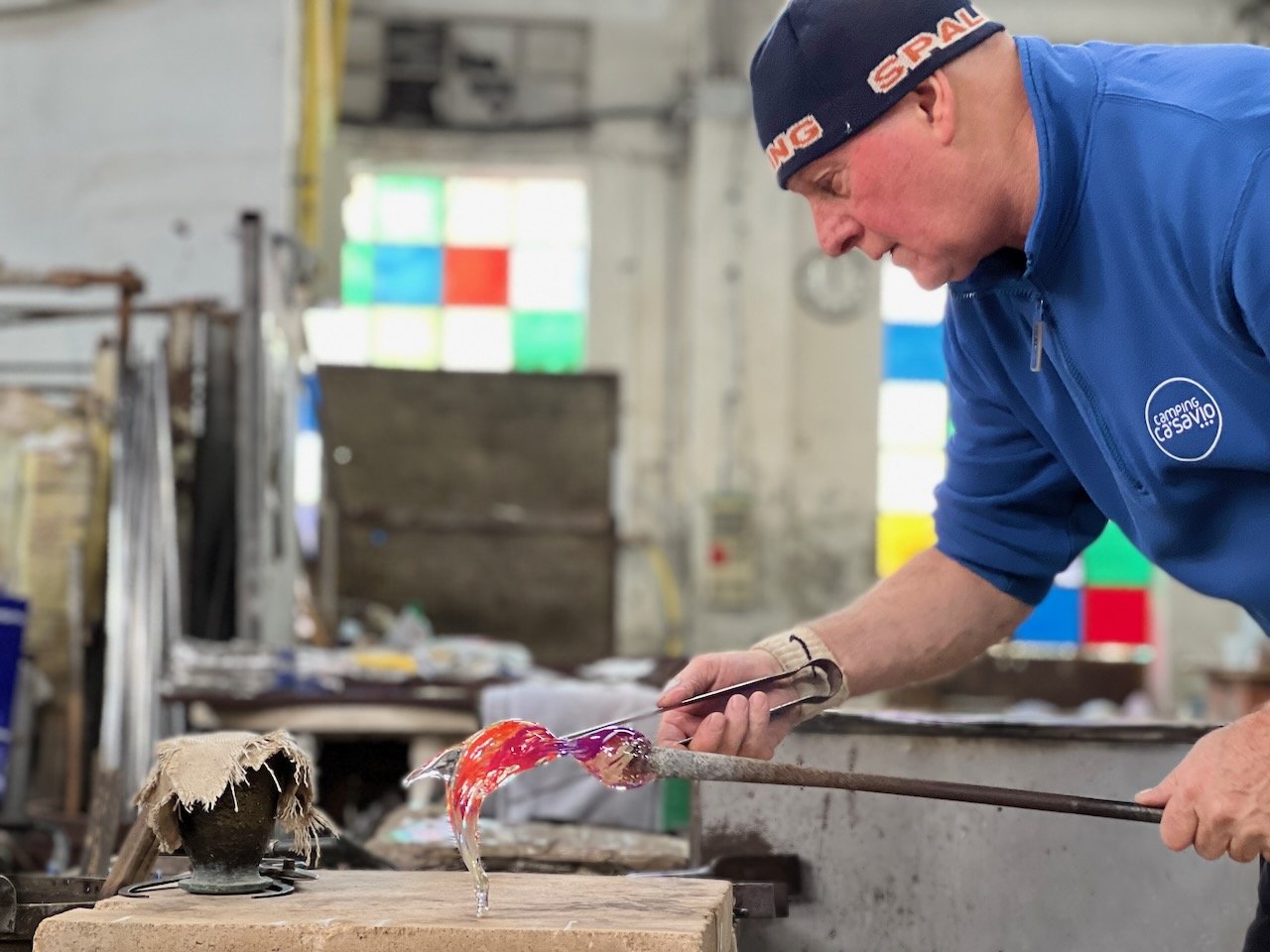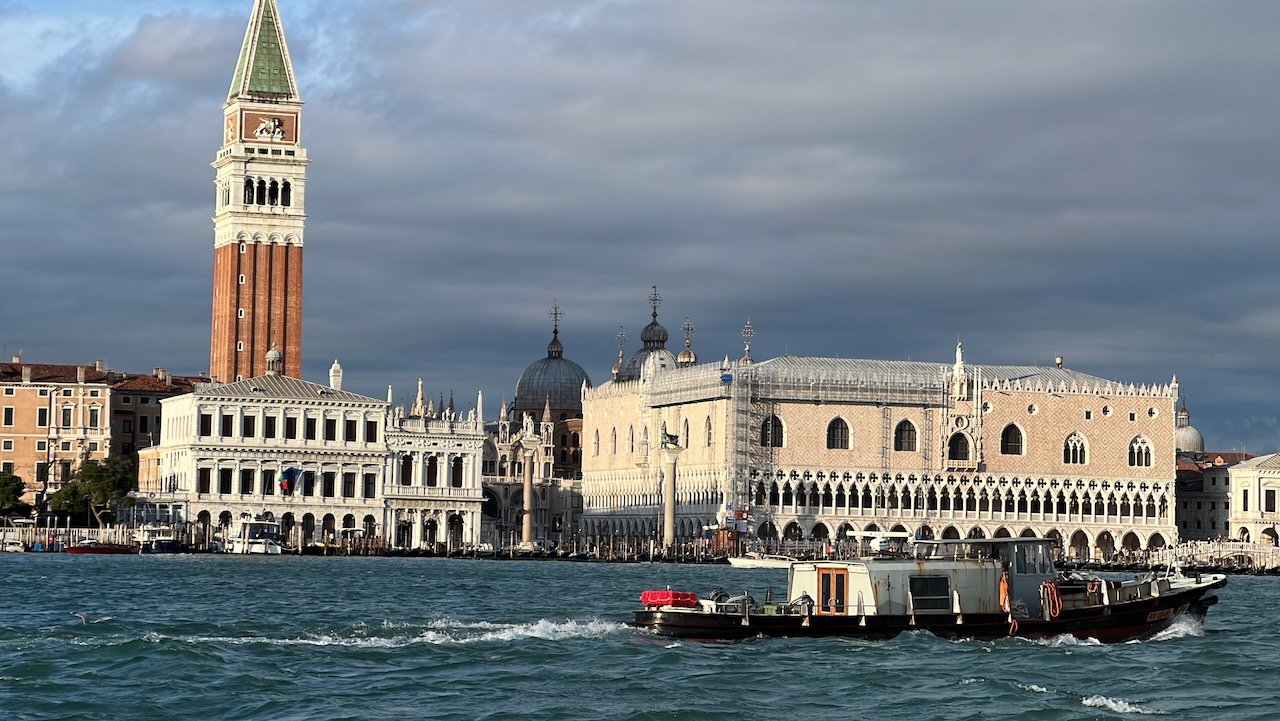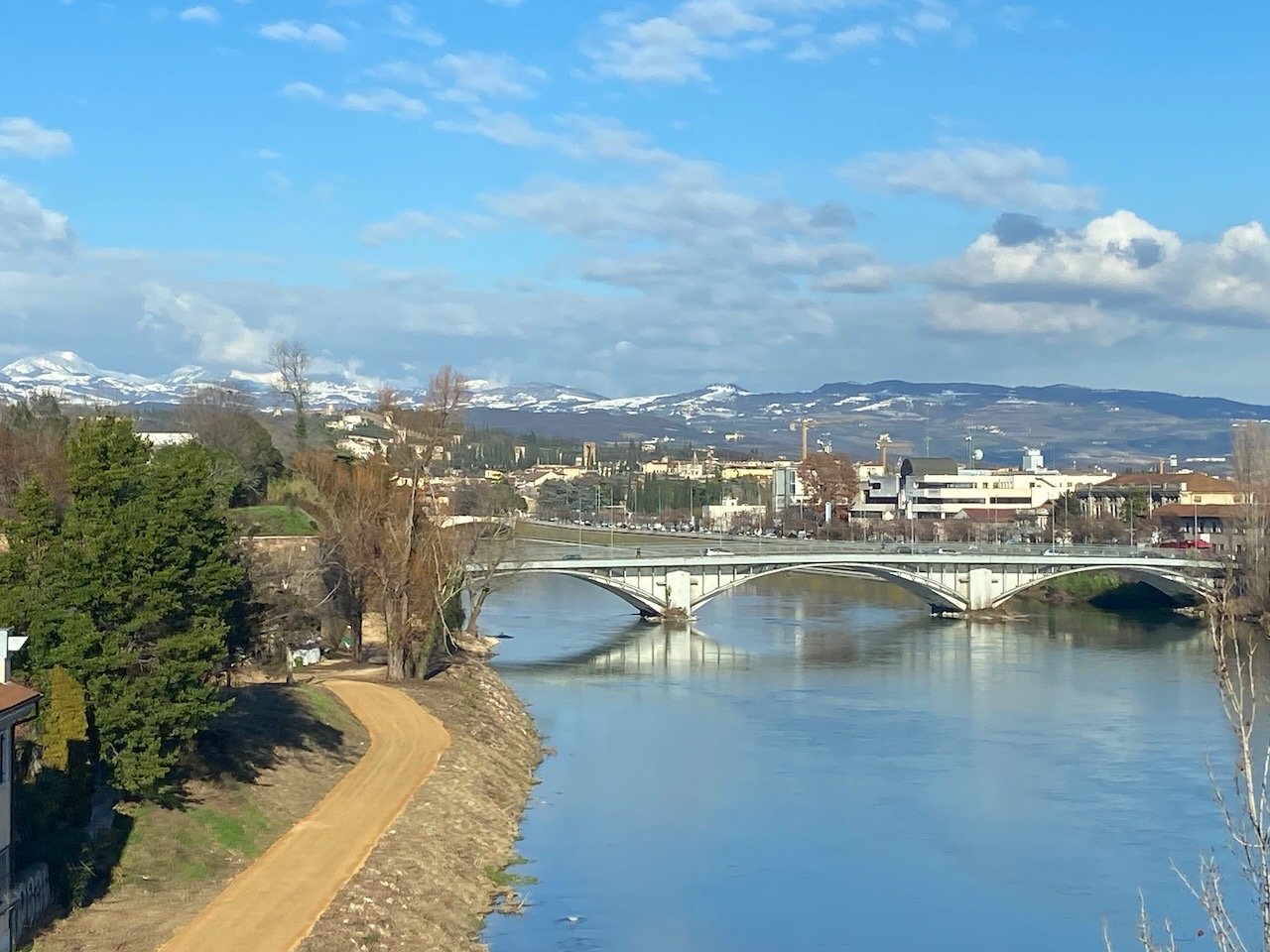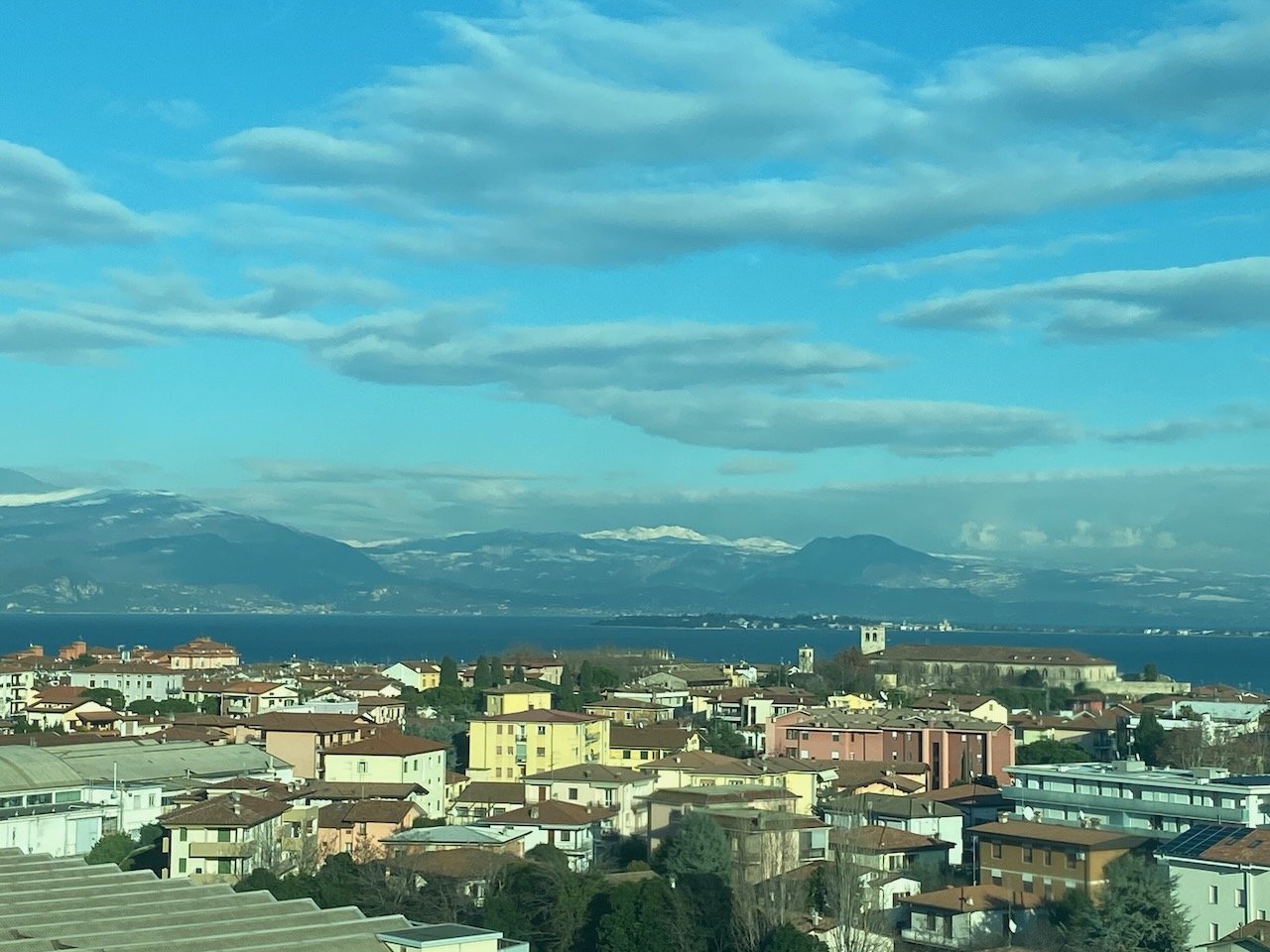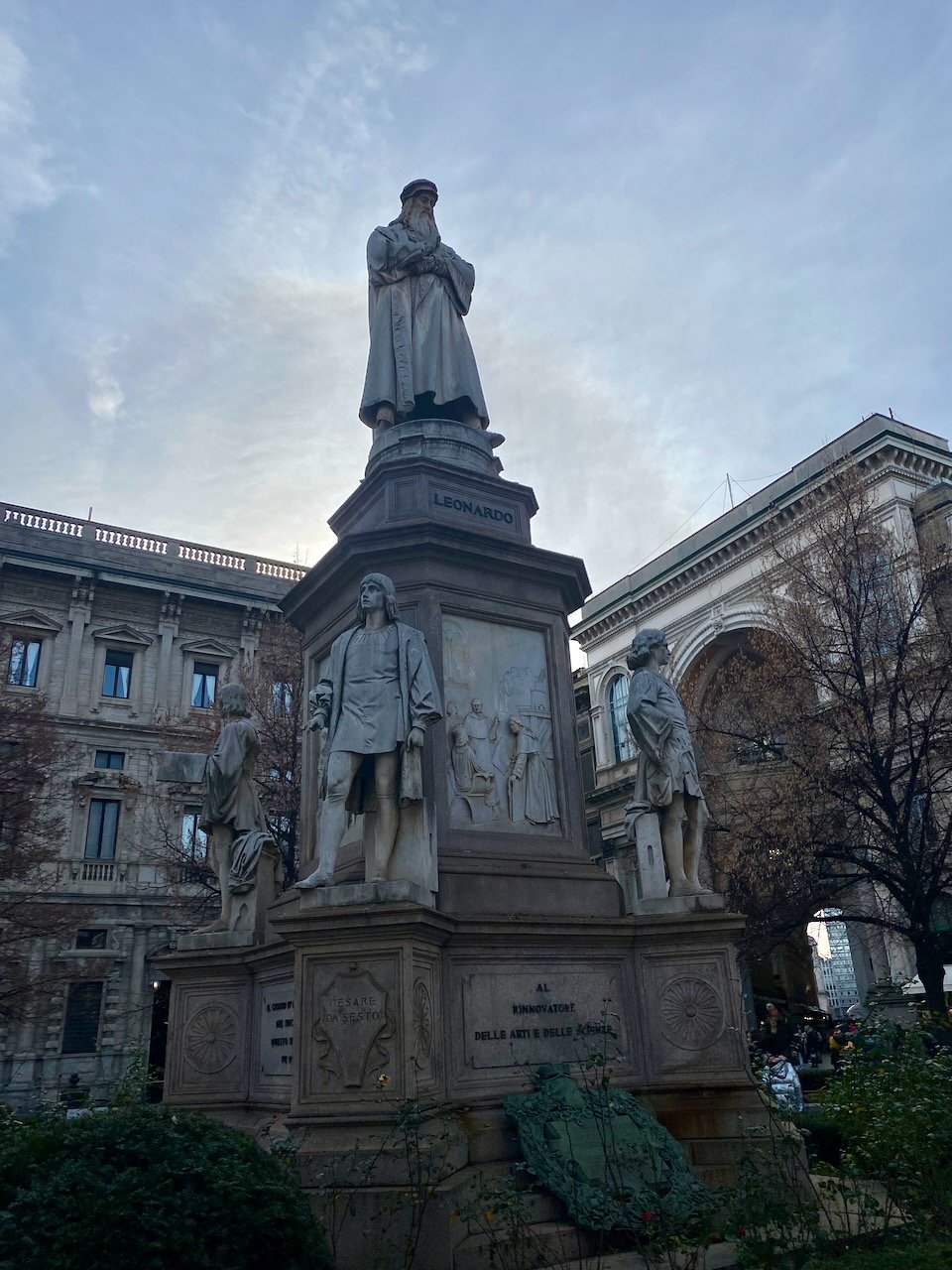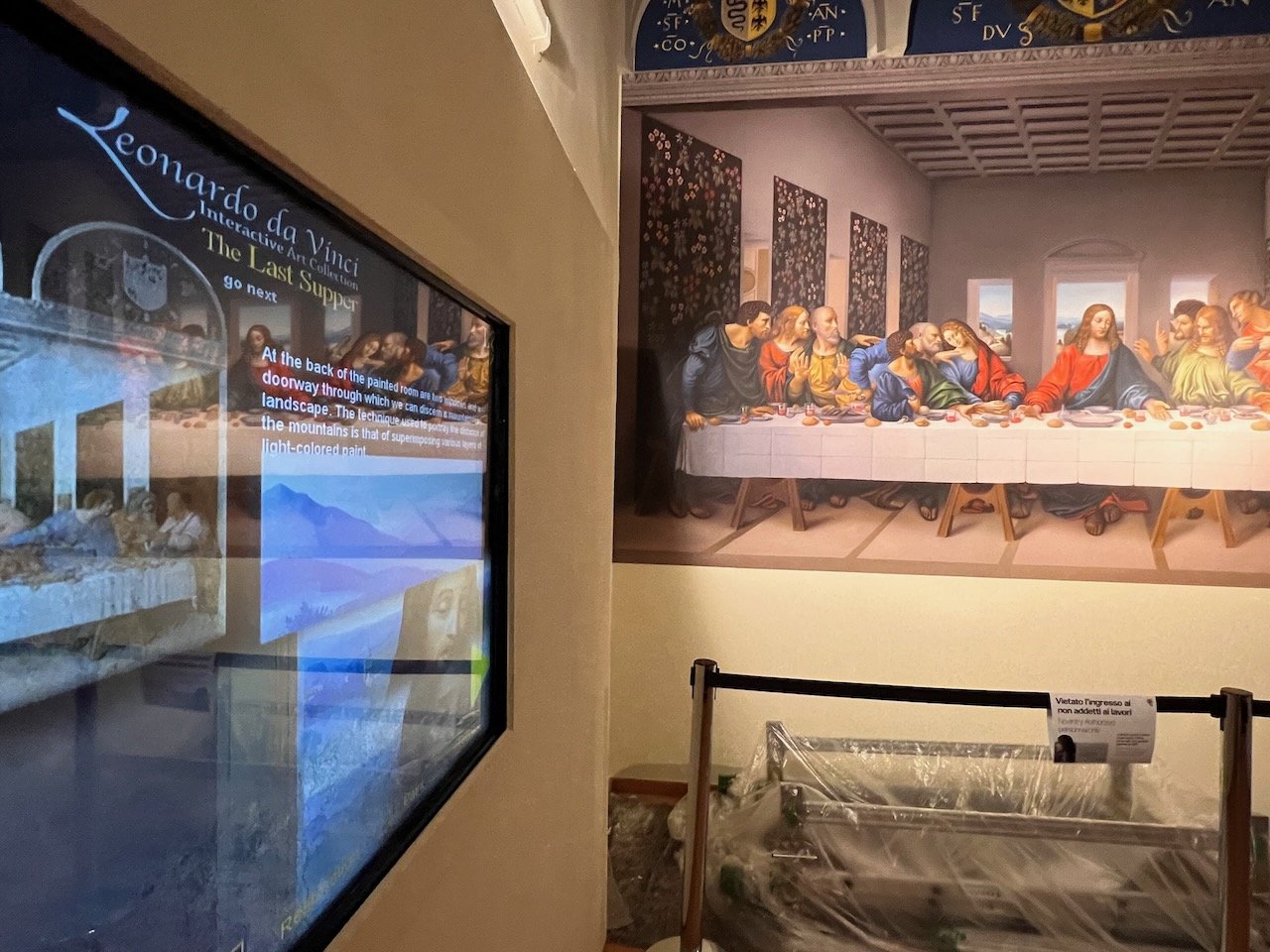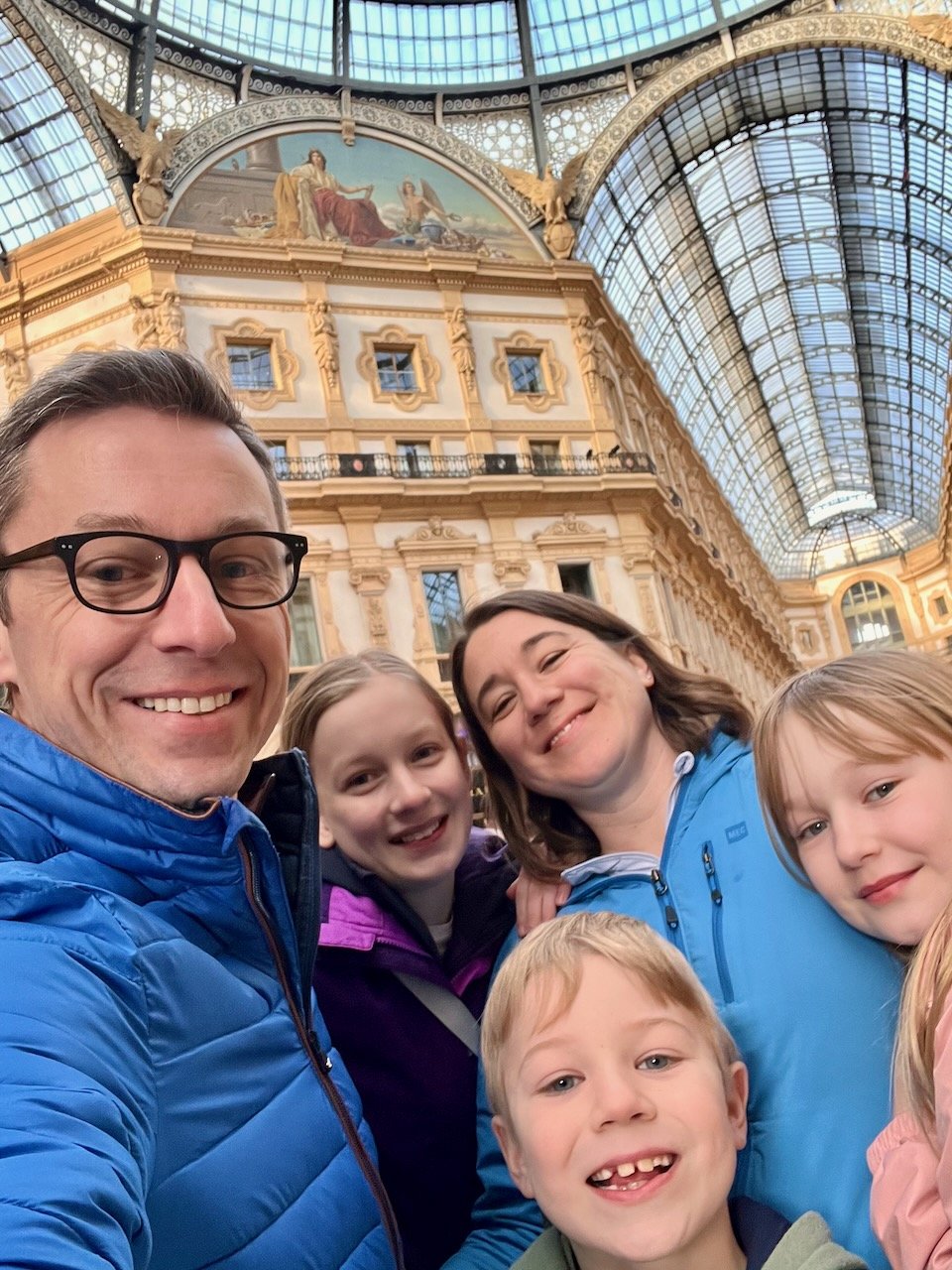Italy… The country of pasta, wine, and cobblestone streets. A place of immense history, rooted traditions, and many nonnas making bread. This is, at least, how I thought of Italy before stepping foot in it.
With our month off, we decided to see as much of Italy as we thought we could absorb via train travel. With Eurail passes in hand, we arrived in Italy on a comfortable overnight ferry from Patras, Greece. The port town of Bari was our first stop. In the planning phases of our trip, we decided to stay one night in Bari instead of getting off a boat and then taking a train to another destination. We didn’t plan to do much in Bari as we hadn’t even researched the place and knew very little about the area. Once we were on the ground, however, we regretted not planning more time. It was a lovely spot! The city had three main areas: the old walled town, the new modern city, and the waterfront/port. We used our day to explore all three areas and found ourselves wanting more.
The modern city streets were lined with stores of brand names, designer companies, and perfume shops. Artists showed their works, and families wandered the pedestrian-only streets. Holiday decorations were still up and lit.
The old, walled city was very interesting. The roads were narrow, with buildings reaching out to each other across the alleys. Flower pots hung from iron balcony railings, and laundry was laid out to catch some sun. We had no particular destination in mind, so we just wandered, got lost, got unlost, and got lost again. We saw the central cathedral and grabbed some seafood as a snack. Restaurants open for dinner at 7:00 pm, so we had to tie ourselves over. We also tried a local item called Sgagliozze: fried cornmeal with salt. It was very greasy. But we chased it down with lovely fried dough that was dipped in sugar; it made up for the salt and grease with its sweetness.
By nightfall, we headed to our rental apartment with pizzas in hand to enjoy a late dinner and an early bed. The city was also very lovely at night.
On an early train in the morning, we made our way through the rolling hills of the Campania Region and stopped for the night in the town of Caserta. We chose it for one main reason: the Royal Palace of Caserta! This was the home to the Royal Families of Naples and was built in the 18th century. What a place!! This home has 1200 rooms, and the back gardens stretch 2.4 km all the way to a water source in the hills. To get the water back to the palace, a long canal was built, and a large aqueduct and storage well directed the water to the main parts of the palace. When we arrived, we wandered the gardens first and found a few geocaches. Lovely bridges, ponds, and paths wound through the wooded areas and were adorned with busts of Roman Gods. It was very charming.
Inside the palace, visitors can walk through a portion of the royal apartments and can see many original décor items and wall coverings. But first, one must climb the grand marble staircase past the lion busts to the open, circular vestibule. Talk about elegance and opulence! The ceilings in every room were painted with angels and saints and gods and fruits in a manner that made the ceiling appear three-dimensional. We had to look hard to be certain that it wasn’t made of carvings. Walls were painted, held tapestries, contained detailed trim patterns, or all three, and stood over 14 ft high. We saw the throne room in which the King would receive guests, the political room in which the King would sit with his trusted advisors and land owners, and we saw the bedrooms and ante rooms where reading, dressing, sleeping, and private time would happen. We saw only a small portion of all of the rooms in this grand estate but we got a good sense for the richness of Italian Royalty of the past.
One quick note about our lunch spot, called Mama Burger, that served us the tastiest burgers we’ve ever had. (Sorry Works Burger, but it’s true). It really hit the spot!
The next morning we rode the train to Solerno where we transferred to a bus to Atrani on the Amalfi Coast. Sadly, the weather was rainy and dreary and made it too foggy to see the full coast line, but we could get enough of a glimpse to know that what we were seeing was something incredible. The bus navigated the narrow, windy roads with precision. We twisted up cliff edges and down into valley plateaus and up the other sides all while weaving through impressively constructed towns. We saw small orchard plots on outcrops of rock, a soccer field on a rooftop, and so many impressive buildings leaning over the edge. Amazing.
When we got off the bus, the rain was coming harder than before and we followed a video showing us how to get to the door of our rental: down some stairs, through a court yard, up some stairs, down a narrow path, up some other stairs, and a quick left turn to our door. Then up four flights to the apartment door, and boom! We walked into a lovely home with views into the valley of the town. We dried off, had some lunch, and waited out the rain.
Once it was dry enough to head out, we walked around the cliff to the town of Amalfi in search of dinner. Unfortunately, a big wave hit the wall and soaked both Simon and Erik – so much for staying dry. They were able to laugh it off and continue. As it was still considered the holiday season, quite a few businesses were closed. No matter, we could see the loveliness of the place all the same. We explored the church and found an open pizzeria where we indulged in tasty pizza and pasta dishes! Our cold, wet bones were warmed with the yummy food and wine.
The next morning we awoke to sunshine, a blue sky, and a wonderful view! We decided to head up the cliff, through the town, to see if we could reach the church at the top. It was a confusing pathway through patios and up the sides of homes, between buildings, and along backyards. We climbed and climbed and climbed. At one point, we reached a gate which was locked and a note which said that the gate was locked except for Sundays. Oh well. The view was pretty epic in any case. On the descent, the kids counted the stairs and agreed that there were about 520 stairs from the beach to the gate before the church. The rest of our day was spent on the beach, hanging out at home, and having a movie night!
We caught two buses the next day to get us to Sorrento and enjoyed the views this time! Only once did the bus come dangerously close to another bus. The drivers somehow got past each other with an inch to spare. It was a longer ride as we wound further along the coast and then up and over the cliffs to descend into Sorrento. Once there, we had a quick lunch and caught a train to Pompeii. Our host, Maria, greeted us, showed us the house, and then started preparing some fresh fruit for us in the kitchen. She made sure we were all eating something before leaving us to get settled. Her place was filled with trinkets and doilies and blankets. She had every surface decorated. She put chocolates on the kids’ beds and a whole pack of chocolates on the adults’ bed. She had snacks and juices and cheeses for us in the fridge, coffee and tea and bread on the counter, and notes stuck everywhere with instructions or with happy messages in different languages. It was a lot to look at, but it felt warm and welcoming.
We got up early to tackle Pompeii. Knowing that it was a huge site, we packed extra water and snacks and walked to the front gate for opening time. It felt like we had the whole place to ourselves for the first hour. We followed a scavenger hunt app and went to a number of notable places in the ruins. We also had the official site app that gave lots of great information. One area in particular had just re-opened after a twenty-year restoration. It is a wealthy person’s home that had remained well preserved. The site was uncovered, restored, and then made to be safely viewed by visitors. The wall paintings were still intact and colourful. It was eerie and also beautiful.
We saw many neat things, such as bakeries with their ovens, market stalls, an amphitheatre, and houses with courtyards. What was really neat was seeing the stepping stones across the big roads that were used to avoid stepping in sewage or rainwater. But on those roads, you could see wear marks from years and years of cart wheels running over the stone roads. Amazing. Former wells had been converted into water-filling stations. The amphitheatre’s benches were mostly original. It’s hard to put into words how the site evoked a range of feelings: awe and respect for the notable technology of the time, loss and sadness at knowing what became of the city.
By noon, we were done. We returned to our rental to get our luggage and make our way to the train station. Our ride into Rome was long but comfortable.
Upon arrival, we had another walk to our place and it was clear that we were pretty tired. But we got there, took inventory, then went out in search of dinner. Pasta and pizza filled us up and we, not quite unanimously, agreed to walk to the Colosseum to see it light up at night. It glowed orange and loomed above our heads. It was larger than we expected it to be – impressively large. We made our way home, put our heads to pillow, and realized we’d walked over 20km that day. Yowza! Sleep came easily.
Over a breakfast of French toast, we decided to make the day our “see the big sites” day by first going to Vatican City and then walking our way back home via a few other key spots. The metro trip to the Vatican City was quite simple and inexpensive. We grabbed a sandwich for lunch and plopped ourselves on a step in St. Peter’s Square. We took in the vastness of the square and the buildings surrounding the square, as well as the numerous statues of Saints all around. After a quick line to get through security, we entered the Basilica and had our breath taken away. Photos just won’t do this place justice. Even for non-religious people, it’s a place where one can stand in awe of something great. We walked freely around the basilica, looked at the various statues and prayer spaces, read about different saints, and stood under the large dome. Once back outside, we joined the line to go up to the dome via the stairs.
There is a walkway which follows the inner edge of the dome’s roof. You can walk along a portion of that walkway and peer down to the floor of the basilica. It’s pretty high! Along the wall are incredibly ceramic mosaics of faces. From there, you can walk up a very tight staircase to the outside top of the dome which gives you a 360 view of Vatican City and Rome. If you’re not a fan of tiny, tight spaces, I’d suggest staying at the bottom of the dome, but for those willing to squeeze a bit, and do the 551 stairs, the views are incredible. We happened to get a clear day so our view was excellent.
After such a big climb, there was only one thing to be done next: eat gelato! We found the perfect place near a lovely piazza where we ate our treat at the edge of a fountain. Italy is full of piazzas, or town squares, which almost always contain an ornate fountain. Speaking of fountains, our next stop was the fontana di trevi, probably the most famous fountain in Rome. It was built in the 18th century at the end of one of the main aqueducts that supplied Rome with water. Simon decided to try the tradition of throwing a coin over his left shoulder while making a wish. We’ll see if it worked.
Another quick stop on our journey home was the Pantheon, a circular building from ancient Rome that first housed temples to Roman Gods and was later changed to a church in 600 AD. We didn’t stay long as our weary feet and empty tummies were pushing us onward. We found some dinner (and a bit more energy) and made our way back to our apartment where everyone went directly to bed! 12.5km for the day.
We pre-booked a family-friendly cooking class for our second day in Rome. We made our way to the location which turned out to be the home of our chef, Fiamma. She was excellent! She taught us first to make the pasta dough; one recipe was only flour and water while the second was flour, water, and an egg. We mixed it and kneaded it until it passed Fiamma’s inspection. Erik’s was the best one, according to her. We had to let the dough rest a bit so we moved onto making the tiramisu, or fiammamisu as she liked to claim. She had already made the thick, tasty cream so we only had to layer the cream with some ladyfinger cookies that we briefly dipped into coffee, and top it off with more cream. The fiammamisu went into the fridge to set.
We then took the pasta that didn’t have egg and we rolled pieces into long tubes like thick straws. We then cut the straw into inch-long pieces and pressed (more like spread) each of those pieces onto a wooden, grooved tool creating a grub-looking piece of pasta called cavatelli. With the second dough, we used her pasta roller to make our balls of dough into placemat-sized, flat sheets. Those sheets were placed on top of some wires. We rolled the sheet to press it evenly into the wires that then cut the pasta into the exact size of noodle called tagliatelle. Fiamma then cooked our two pastas, mixed them with some pre-made sauces, and served us some of each. They were really good and she said we all passed because all of the pasta was done well. Then we finished our meal with the tiramisu and had to roll ourselves out of the house.
The closest metro station to our cooking class was at the Circo Massimo, a former chariot racing track that is now an open park with some original ruins to view. It’s pretty neat to think about how long ago chariots raced on that very spot! That was all we did for the day. We needed a bit of rest and relaxation so we stayed in for the night and made our own meal.
For our final day, we had to start off with switching hotels. Luckily, our new hotel would hold our bags for us until our room was ready (not for free, of course) so we first dropped off our things and then made our way to a Sunday market. It was over a km long and consisted of mostly clothing, bags, and books. We peeled off for lunch before reaching the end and found a fancier spot where we tried some new pasta combos. As a family, we decided that we did want to go inside the Colosseum so we made our way there and got onto the final guided tour of the day.
There was a lot of security which took over 25 min to finally get into the structure. Once in, we were rushed around fairly quickly by our ambitious but knowledgeable guide. Not all tours allow you to stand on the ground floor where the fighting took place, but ours did and that was the first place we went – onto the arena floor like a gladiator. She pointed out how we know where the important guests would sit, why everything had holes in it right now, and how animals and gladiators would be raised up from below in elevator-like systems.
We then got shuffled into the stands where could see the arena the way a spectator would have seen it. We saw some museum displays and information signs and she pointed out some key spots including where one could see an Egyptian obelisk. She gave us a few minutes to take some photos and shooed us out the exit as the site was closing. We had to skip the gift shop but were glad for our chance to go inside at all. To finish the evening, we found an old wine cellar turned into a restaurant and ate some fantastic pizza.
The train ride to Florence was our roughest yet. I suspect part of the challenge was being really pooped from three full days in Rome. Another part was the very poor-quality hotel breakfast that didn’t nourish us. And the final issue was not having a chance to grab a decent coffee before boarding. It was a 3.5-hour train with a number of stops and no food or drinks. The kids were cranky and their mother wasn’t sufficiently caffeinated to tolerate them. We got off the train in the rain and had a twenty-minute walk to our rental apartment. Moods deteriorated even further until we walked into our place. It was lovely and roomy and had two bathrooms!!! It belonged to a company that caters to digital nomads by providing short and long-term apartment rentals in key European cities. And as though fate was speaking, sitting out on the counter waiting for me was a whole canister of Grind coffee pods and a coffee machine! Finally!
For the rest of the afternoon, we each wanted to do something different. To solve that issue, the parents insisted we all do the same thing. Logical, right? We went out to see the city (and get a late lunch) and to try one of the scavenger hunts in our app. It didn’t go so well, naturally. But we did manage to notice how clean, walkable, and pretty the city was. We also found gelato, shopped for berets, and found groceries for dinner and breakfast. That evening, the adults went down the street for a dinner out to try some boar and some papadelle pasta – both a regional recommendation from Fiamma. Double Yum!
For our full day in Florence, we decided to go to the Accademia Gallery first to see the statue of David. It was another cool and rainy day so being indoors was a good thing. We started by viewing a number of Renaissance paintings in the main gallery room. To our untrained eye, they were nice and colourful paintings of people with angel wings and babies eating grapes. Reading the information signs, we learned that the collection was from Florentine painters from the 16th and 17th centuries. Off of the main gallery is a room housing a number of musical instruments including some Stradivari violins! We heard a stringed instrument that made sounds that are very similar to a trumpet.
But the main reason to go, of course, was to see David. The gallery first takes you through a room with some of Michelangelo’s unfinished sculptures which helps you see his process. For example, he starts shaping the head and face before working downwards to the body. His original David statue stands at the end of the hall with his confident face and his sling shot over his shoulder. He was pretty large, again larger than we expected. Impressive.
The final room we visited was called the Hall of Busts. It was quite literally filled with busts of many faces. This room taught us how sculptors would create the smaller, model busts first and then use nails placed in mathematical points to help the sculptor measure and scale accordingly. It was quite interesting for a room of faces.
The final Florence stop on our list was to visit the Ponte Vecchio, a medieval stone bridge (the only one in Florence that survived WWII bombings) that is lined with lovely jewellery stores. We window-shopped for a little bit, snapped a few photos, and headed for home. Florence seems like a place to visit, perhaps without kids, if you love wine, food, history, and/or art.
Our train the next morning left a different station than the one at which we arrived. We decided to walk although the distance was greater. Simon struggled with his load and the distance. We did it through teamwork and had some time to spare as our train was delayed. This stretch of the trip was supposed to be full of beautiful scenery and I was particularly excited. Unfortunately the weather wasn’t cooperating and we had chosen to take a high-speed train to shorten the trip which sped through tunnels at a number of locations. The vistas were not very beautiful, sadly. But that all changed when we stepped out of the main station in Venice and were presented with the Grand Canal. A quick price check for a water taxi revealed that we’d be walking to our hotel. It was very expensive!
Thirty minutes of narrow streets, stone bridges, and lots of pausing for photos, we made it to our hotel room and dropped our loads! From the preview of shops we’d passed along the way, Claire was eager to get back outside to go shopping. Simon was eager to stay plopped on the bed. Erik was eager to show everyone St. Mark’s Square. Naturally, we argued about what to do first and decided to have a snack, meander towards St. Mark’s while window shopping, and find dinner, but only after 30 more minutes of plopping.
Venice is unlike any place we’ve ever been and we found ourselves pausing often to stare at a small gondola pushing along a small canal or wood-paneled boats escorting guests to destinations. We saw delivery carts with a special wheeled system for going up and down stairs. It was cool and not too busy, but still bustling with activity. St. Mark’s Square was larger than I expected it to be on such a small island. The neighbouring buildings were grand but not too elaborate, until we got closer to the basilica and saw the ornate details on the building. The sun had set, the air was cool, and we needed some food so we found a restaurant on our way back to our hotel that filled our bellies with excellent pasta!
Hotel breakfast was served to us in our room. How fancy! We caught an early ferry from close to our hotel to the island of Murano where we intended to spend most of the day watching glass blowing demonstrations. The island is quite small with one main “road” (canal) along which are mostly glass shops and restaurants. We walked the strip and gawked at all of the amazing pieces of glass art we could see in the stories. There were lamp shades, wall hangings, stemware, and figurines; pens, containers, and décor items; and jewellery, jewellery, and jewellery.
At the first demonstration location, we were escorted into the workspace where we could sit and watch an artist named Massimo at work. While he did his thing, another guide told us what he was doing, what he was using, and why each step was important. He first created a vase, then he made a dolphin figurine when Simon suggested a dolphin. From there, we were led into the showrooms where so many lovely pieces were on display. We found a vase we liked that had been made previously by Massimo. He agreed to a photo with us and the vase.
Our second demonstration was hard to find and once we got there, they didn’t seem to be open. They demonstrated a horse figurine which was quite incredible and then, somewhat begrudgingly, showed us their smaller showroom. The pieces were so elaborate and expensive but extremely beautiful. This workshop generally works only on commissioned pieces and tends to focus on chandeliers. We thanked them for their time and left empty handed. We grabbed some seafood lunch before hopping back on a taxi to go to the mainland for our next event.
We made a small error in choosing our taxi and ended up arriving at a port that wasn’t as close to our destination as we’d hoped. We had to walk quickly, but we made it to our mask making appointment on time! A lovely lady named Veronica welcomed the kids and had them choose a pre-formed mask from a number of options. Once they were selected, the kids were given instructions on how to create an ombre base with two colours and they got started on decorating their masks.
Venetian masks have a history that is long and interesting and worth a read. For our benefit, let’s just say that the masks were used for celebration, inclusiveness, and anonymity. But the wearing of masks and the celebration of carnival were banned in the 1900s when Italy was ruled by dictatorship. It is now back in action and this one shop in Venice has devoted their time to learning and replicating the traditional methods of mask making. Veronica and her coworkers were working on creating masks for the upcoming Carnival celebration and had lots of lovely masks drying in the workshop.
After an hour and a half of intense focus and work, the kids had some beautiful masks to keep as souvenirs of their time in Venice.
One full day in Venice is not enough. We tried to use our morning to see a few more things, including heading back to St. Mark’s for a daytime view. We were shocked to see the square half covered in water. It’s apparently a common occurrence at particularly high tides to have the water creep into the square. Platforms were erected for people to traverse without getting wet. Many others had disposable plastic boot covers that reached their knees and were just wading around in the water. Unfortunately, we were pushed along the platforms and were not allowed to stop walking to take photos or videos, so we grabbed a few moving shots and made our way out of the area to higher ground.
Our train ride to Milan was both stressful and beautiful; stressful because the trains were fairly full and we had to split up to find places to sit, and beautiful because we had a sunny, blue-sky day and traversed the rolling foothills along the southern edge of The Alps. The second train ended its journey one stop too soon for what we expected so we found a metro line and got closer to our hotel before setting out on foot. The hotel was very basic and a few of us were beginning to feel warn-down. I had a sore throat. But we needed dinner so we found a Turkish donair spot close by and filled our tummies before bed.
We had one full day planned for Milan and three things we wanted to see, all of which were in the same area of the city. Our first stop was the Leonardo3 Museum: The World of Davinci. This little museum was a gem! Many scholars working with Leonardo’s drawings have created models of the inventions that were never prototyped (to our knowledge). We could see the model and then interact with a digital version to see how it was designed and what it may have been used for. There were a number of flying machines but also many defense machines such as a floating cannon and a mechanized guard who moved every so often thus appearing to be a real human.
Another section of the museum focused on some of the many musical instruments he designed. The one that stood out to me was similar in concept to a bagpipe where an air compartment could be pressed between your arm and side to create a steady flow of air. This contraption, however, had two such compartments so that the musician could press left and right in turn and never have the flow of air cease. This was also designed in a way that it could be attached to a number of different woodwind instruments of the time, making it very versatile!
The final part of the exhibit that was quite interesting was an area dedicated to the digital restoration process of Davinci’s famous painting, The Last Supper. It showed us the many, many steps undertaken, the vast amount of technology used, and some of the very intriguing details that they were able to reveal through this restoration process. For example, to the naked eye, one can not see a large bell tower in the background of the painting. With the restoration, you can now see it and other details of the background. There was also a tipped-over salt container on the table that had been lost over the years of fading. Although we are not intimately familiar with the symbolism of this painting, it was still very neat to see the “best most original version” of this painting in the museum.
Since the museum is right beside the Galleria Vittorio Emanuele II, we wandered through Italy’s oldest active shopping gallery to marvel at the roofs and décor. The shops were too high-end for our taste, but we still enjoyed the ambiance of the mall. It was interesting to see how nicely dressed everyone seemed, including the dogs who all sported fashion-forward sweaters and coats, often matching their owner.
Just beside the Galleria is a popular spot to grab a panzerotti. It was a big line to get them, but they were worth the wait!!
The final spot we wandered through was the Domo di Milano, one of Italy’s largest cathedrals. It was built in the height of gothic architecture and is swarming with spires and statues. We did not go inside, just gawked as we walked its length while scouting out a geocache and looking for the Apple store. A quick walk through Apple to see the newest laptops sealed our outing and we made our way back to the hotel for some down-time (and laundry).
What a trip! Sixteen days, one ferry, three buses, eleven trains, and a number of trips on different metro systems, and we’ve now seen a mere sample of all that Italy has to offer. We found train travel to be simple, comfortable, and convenient and we’d do it again in a heartbeat! You can watch our antics on our short video here.













